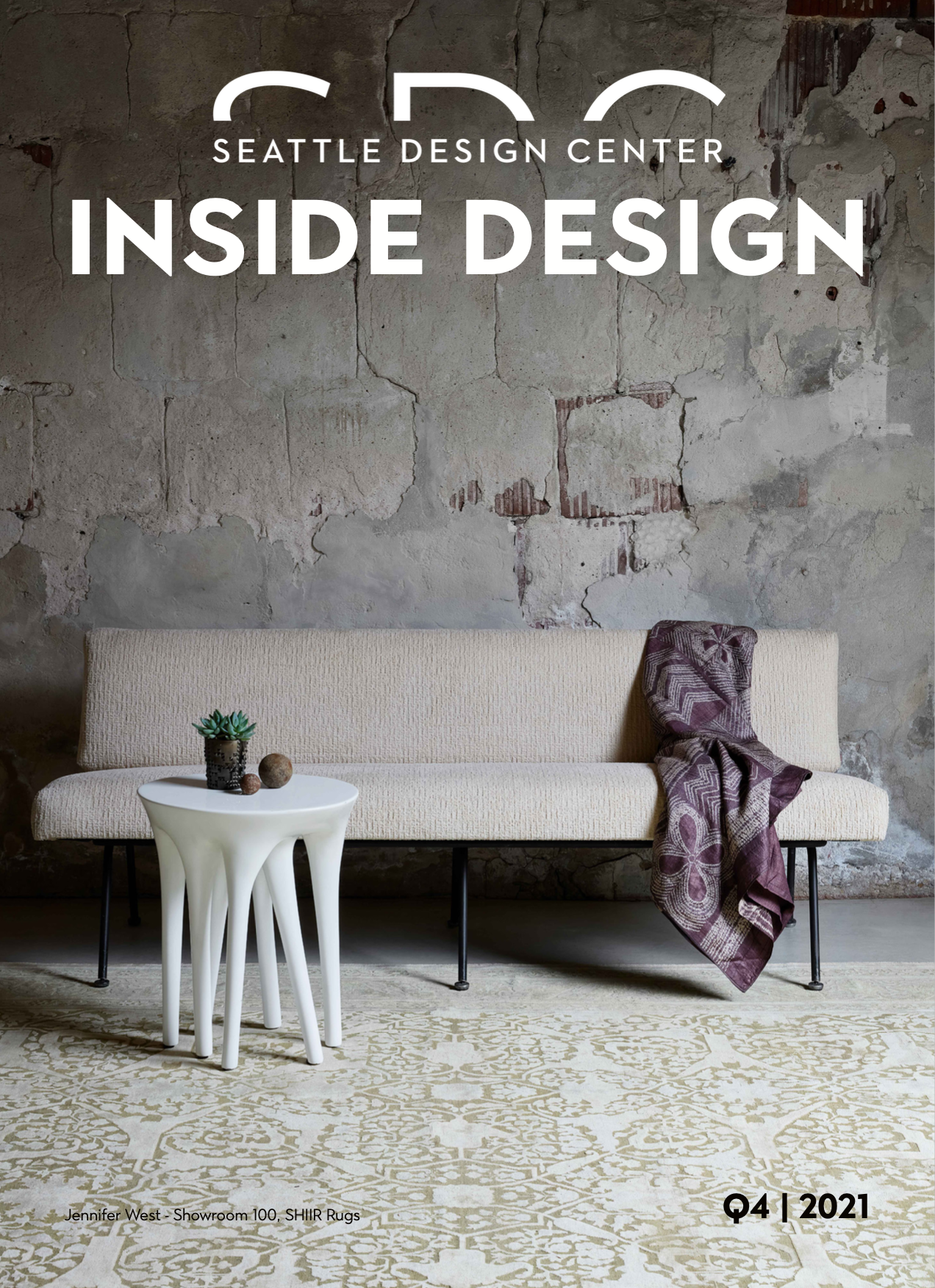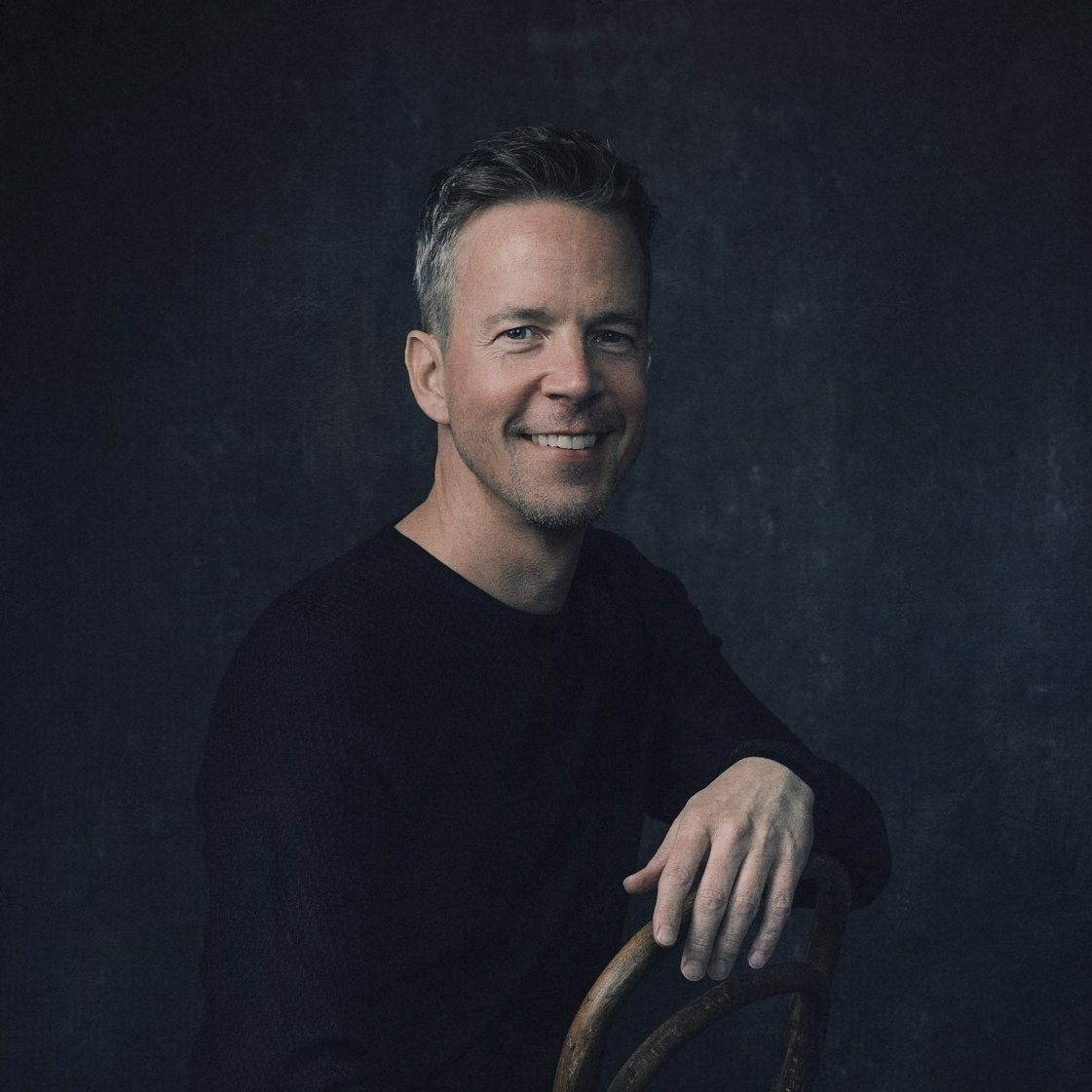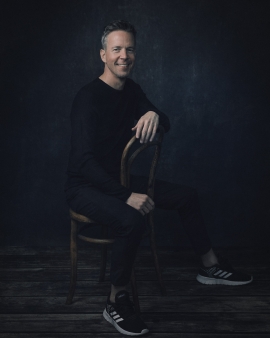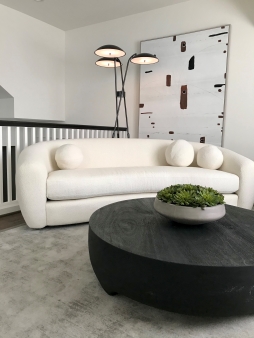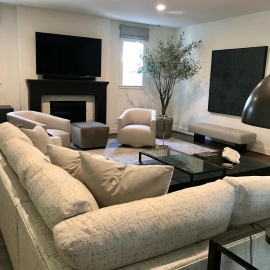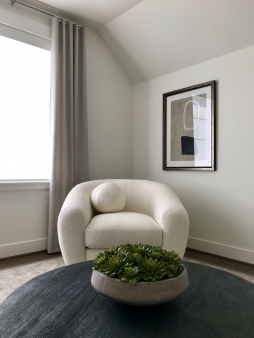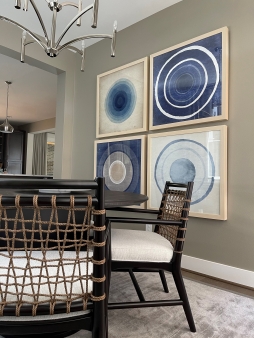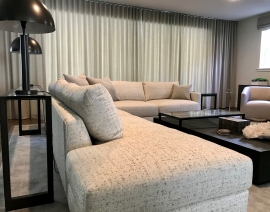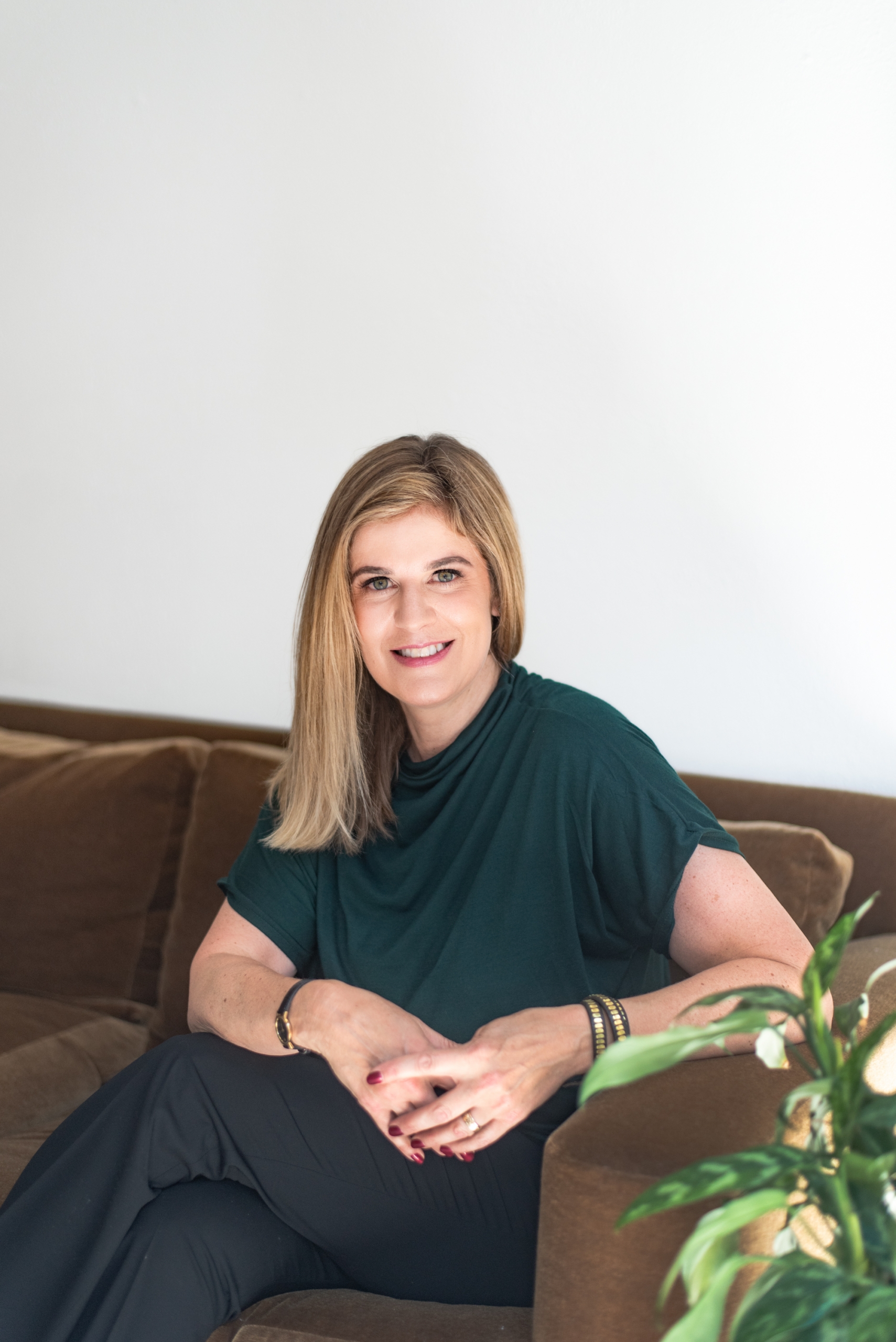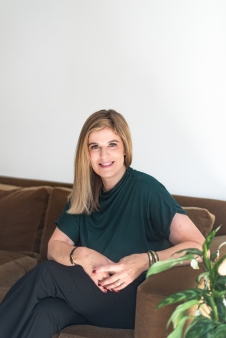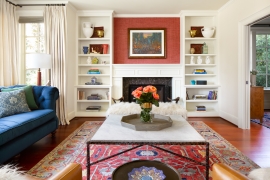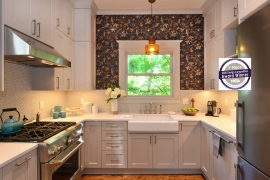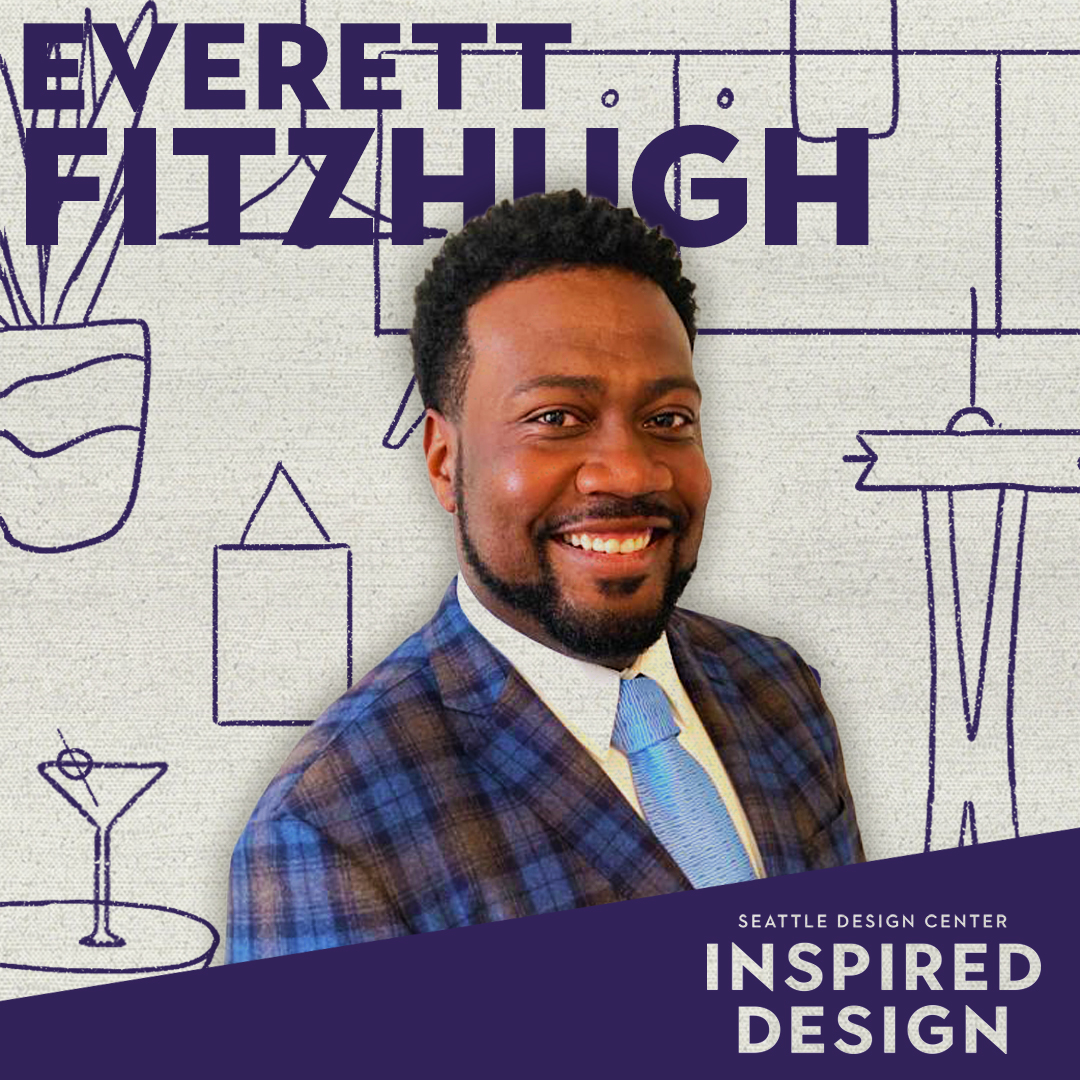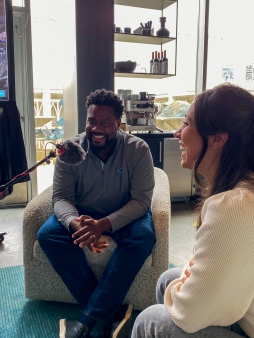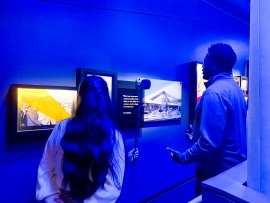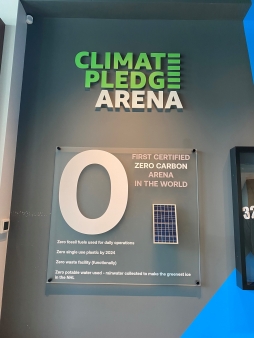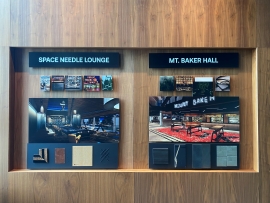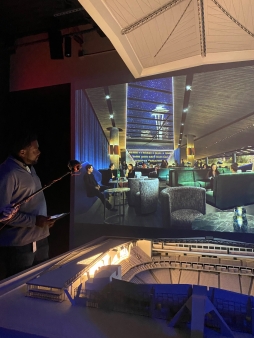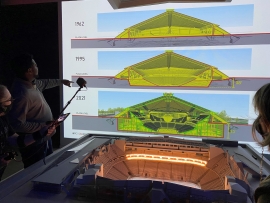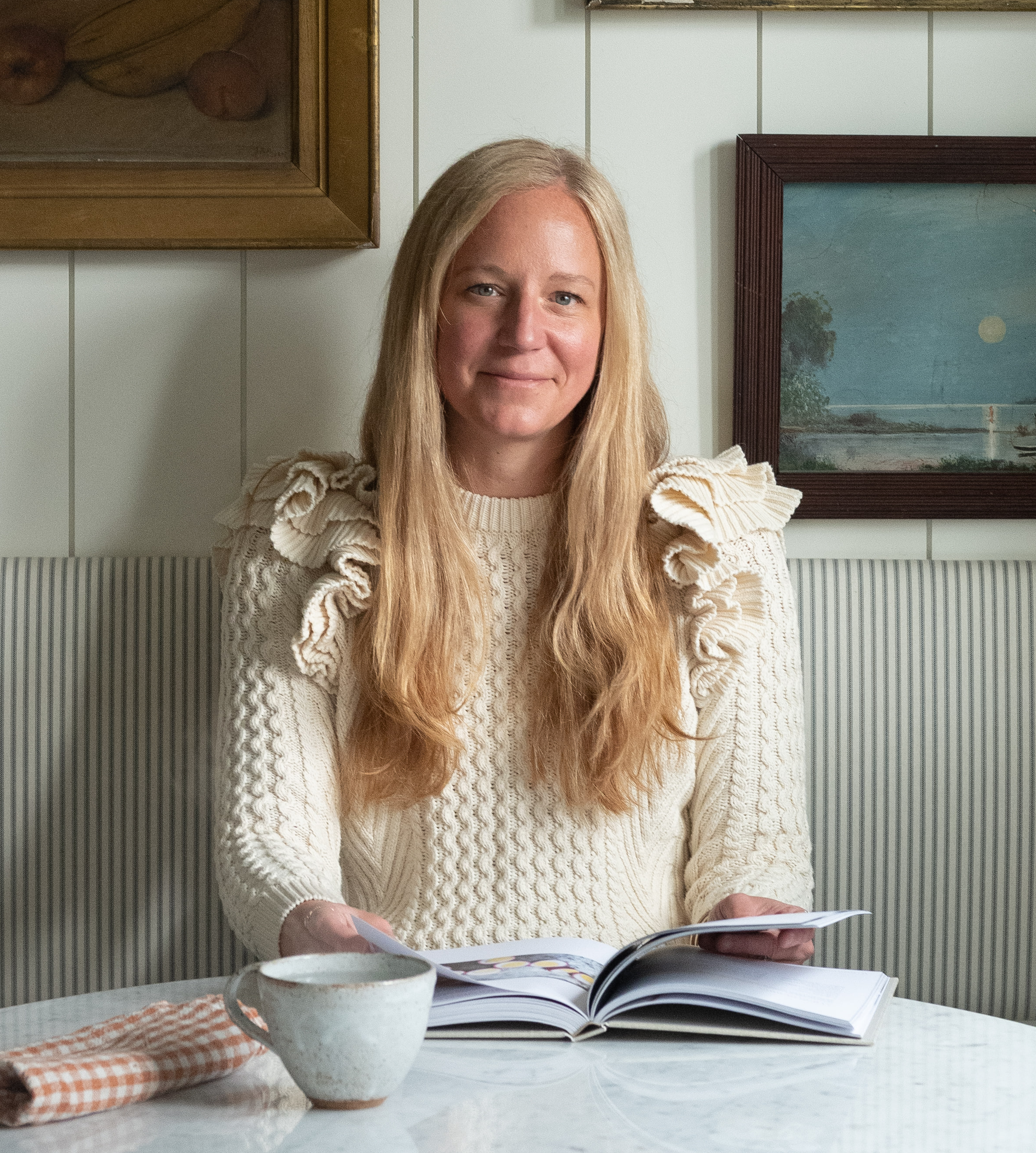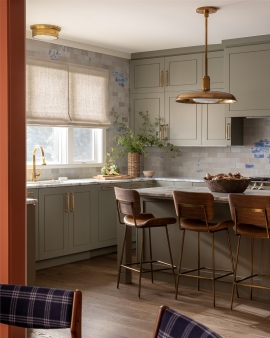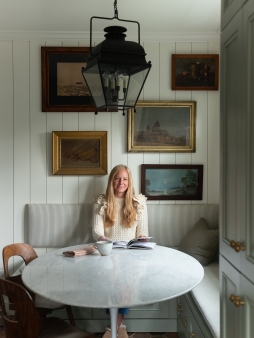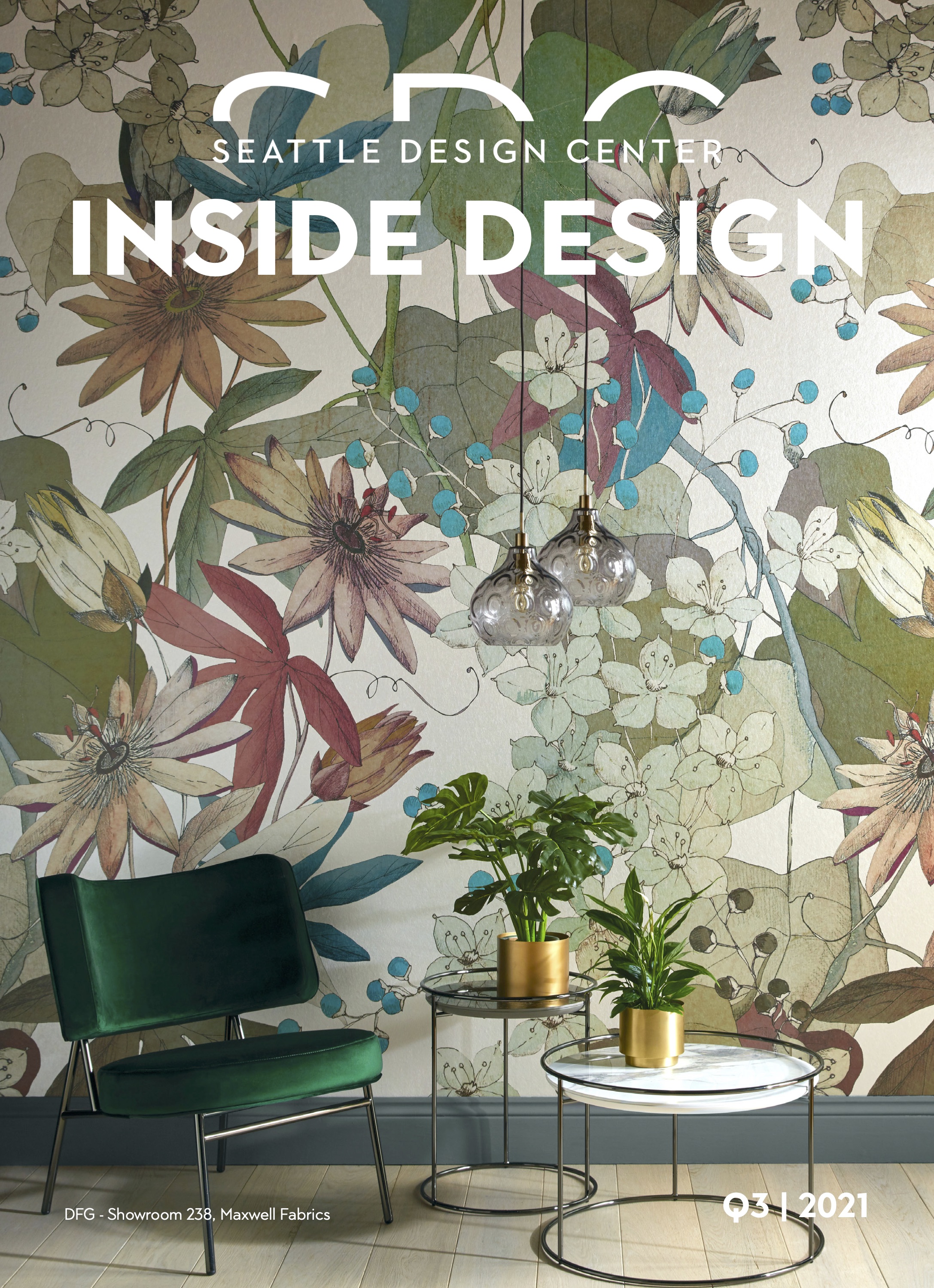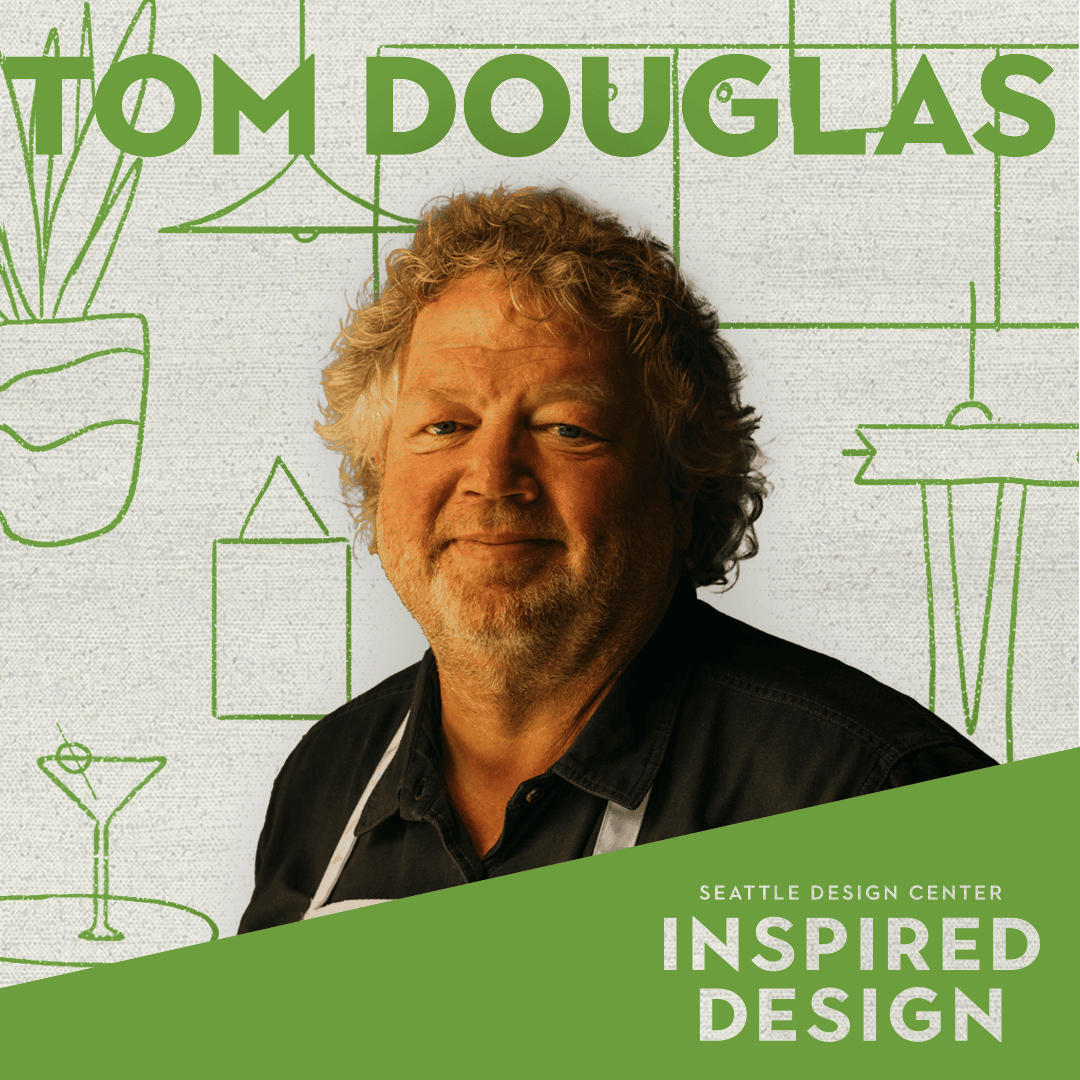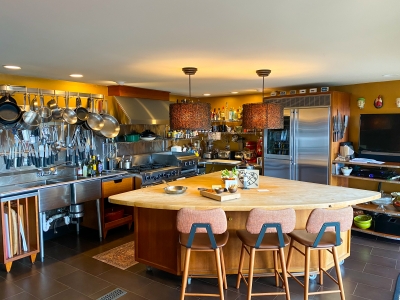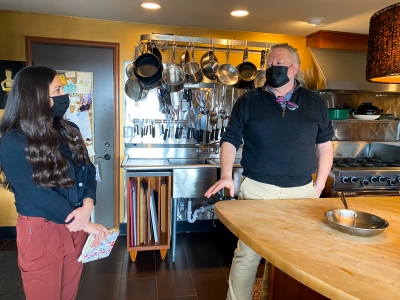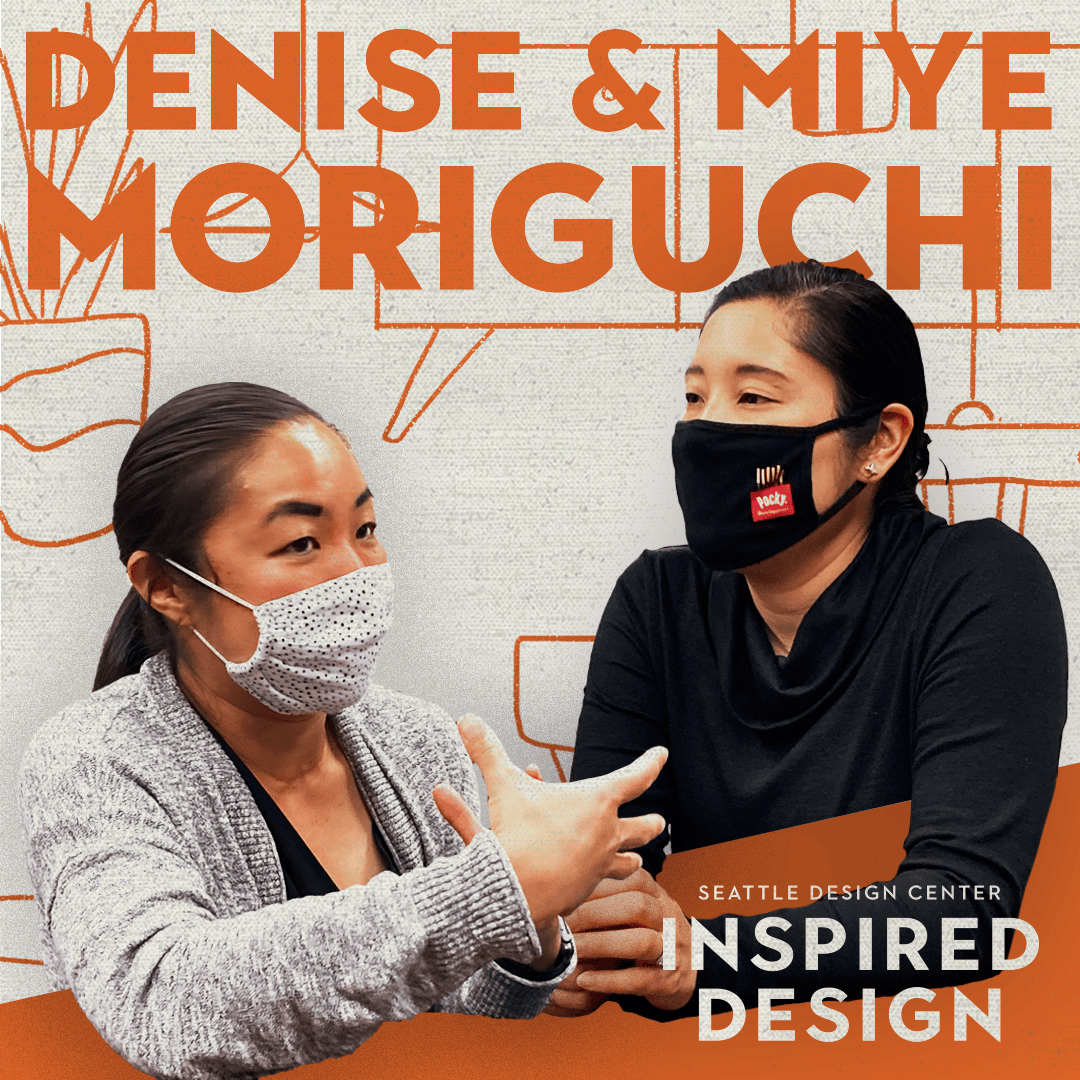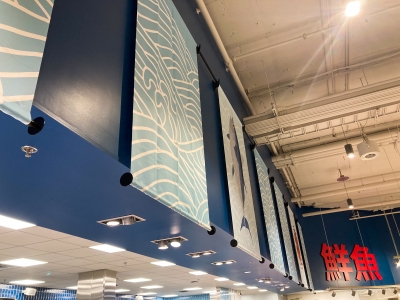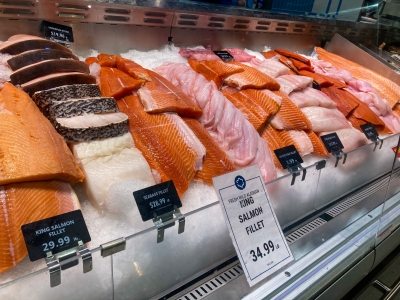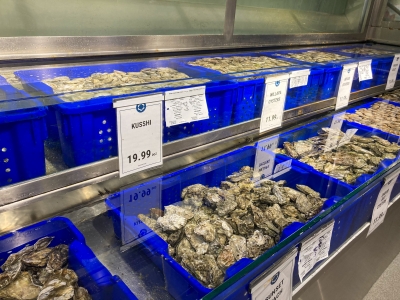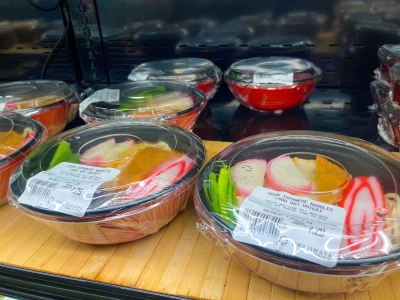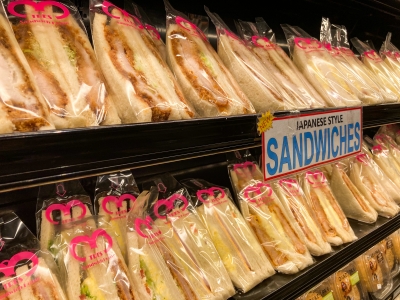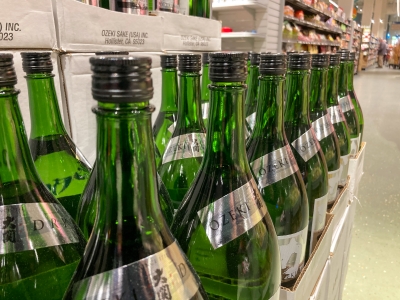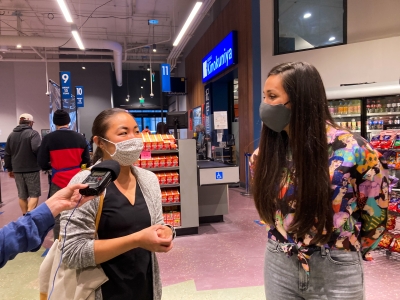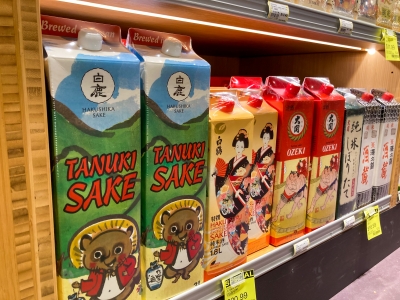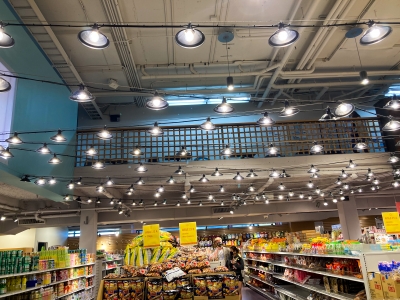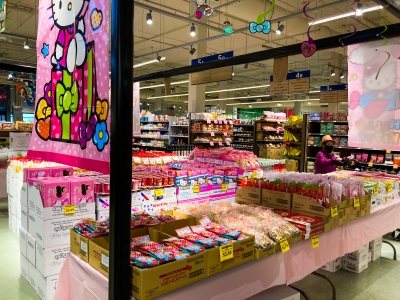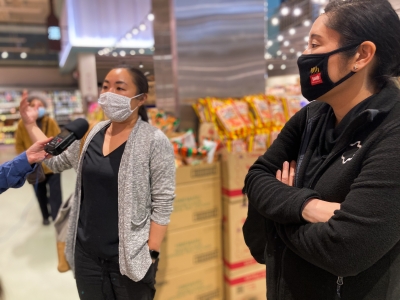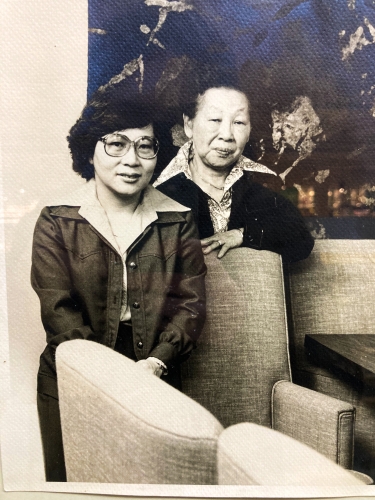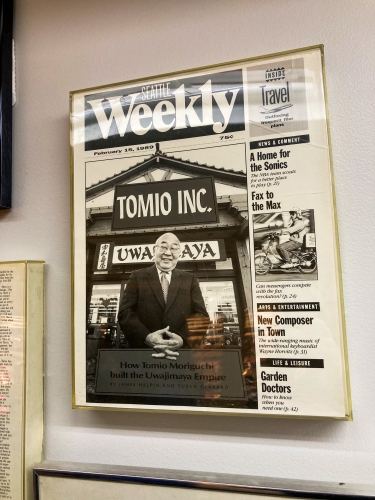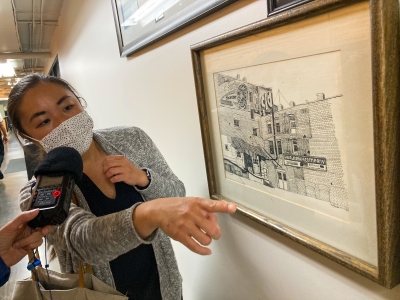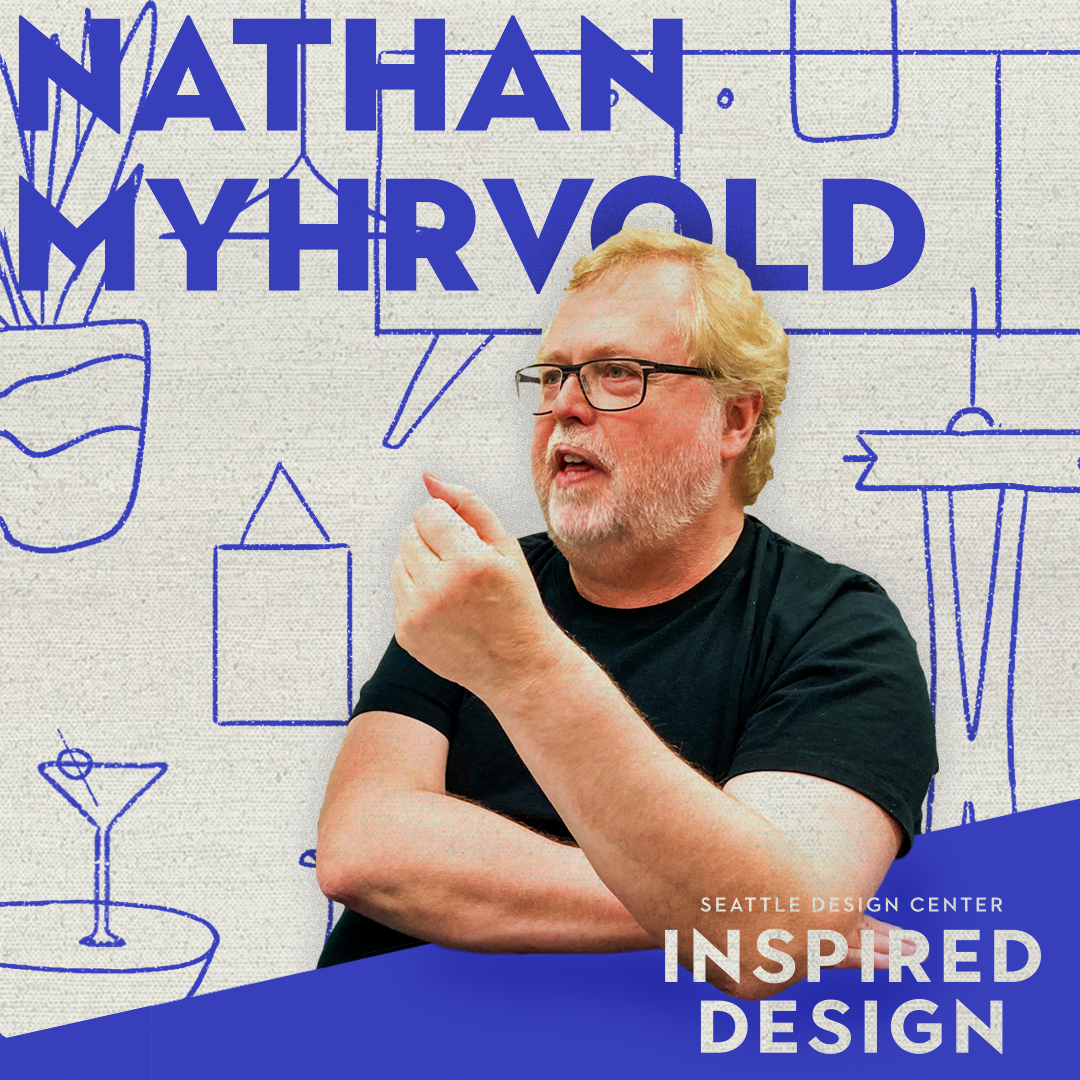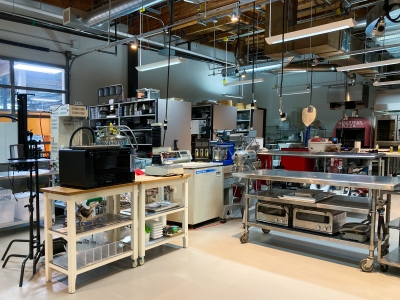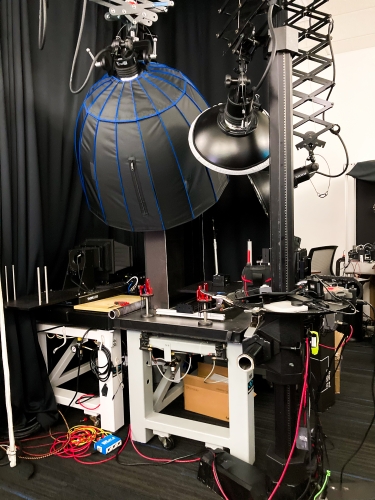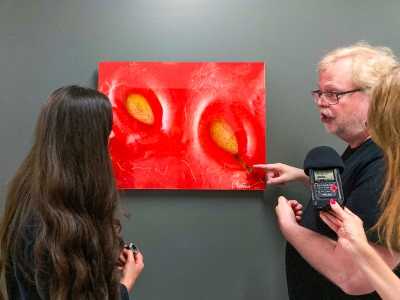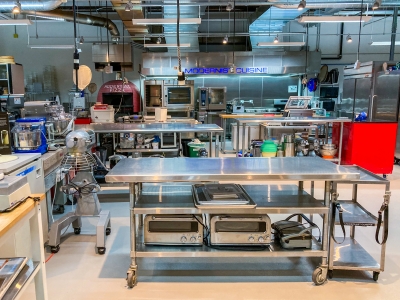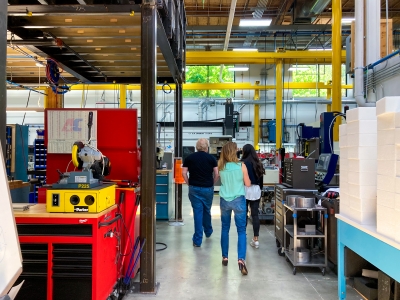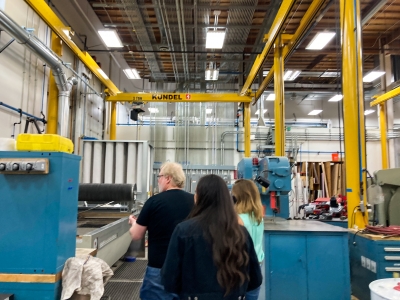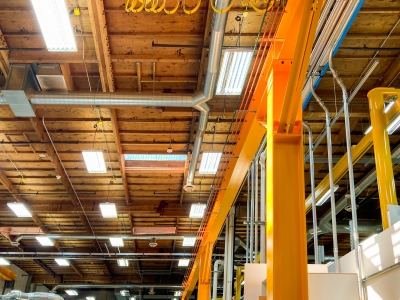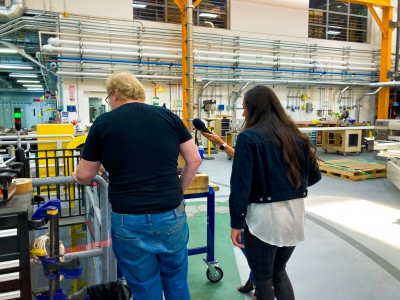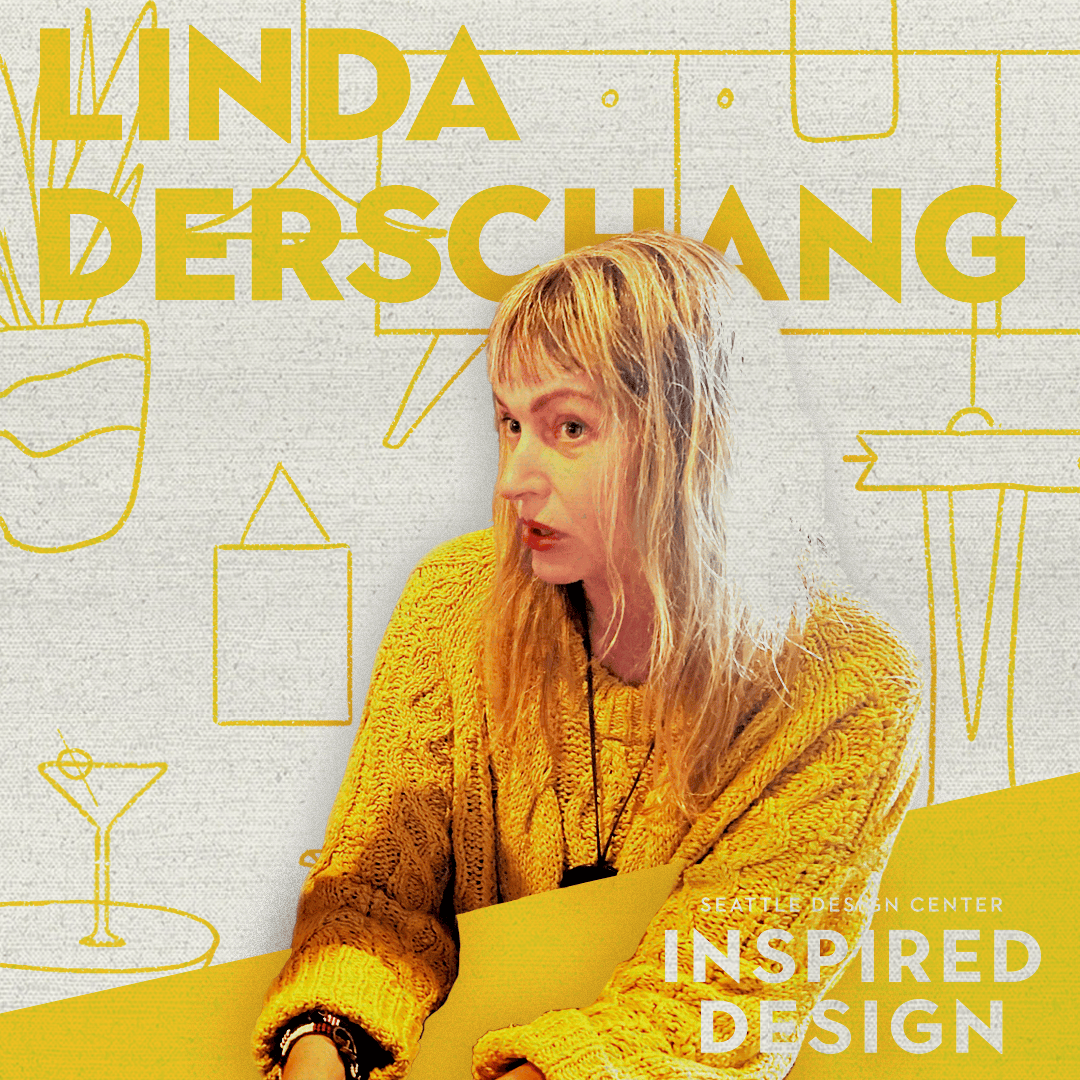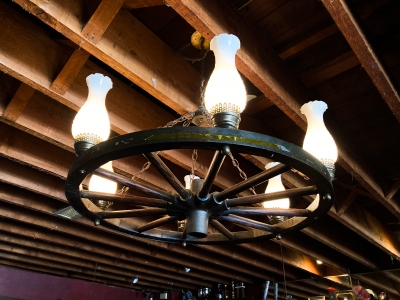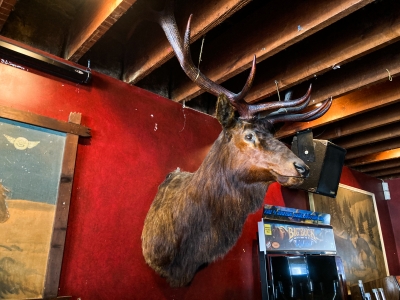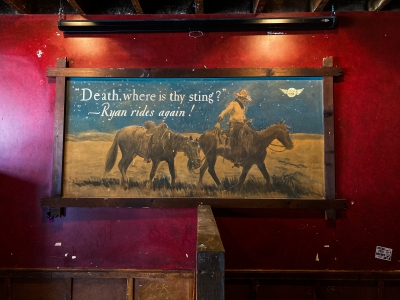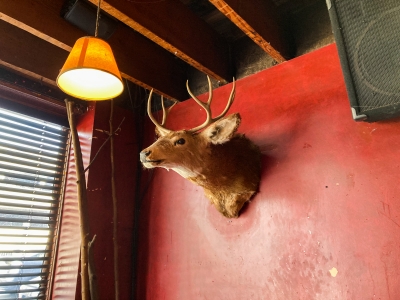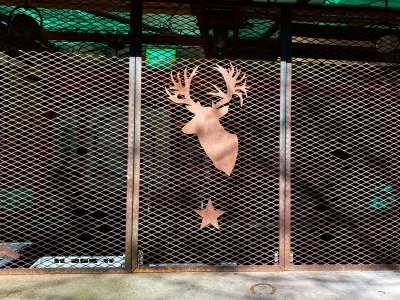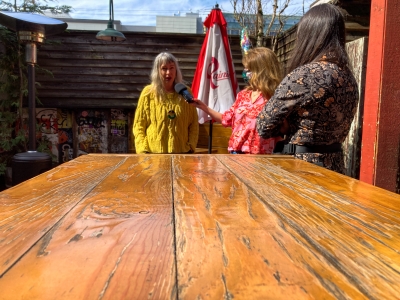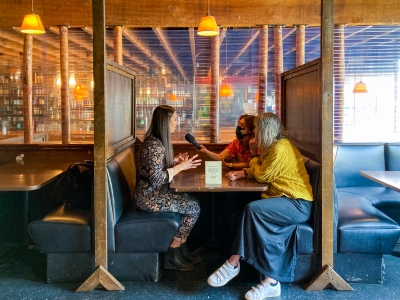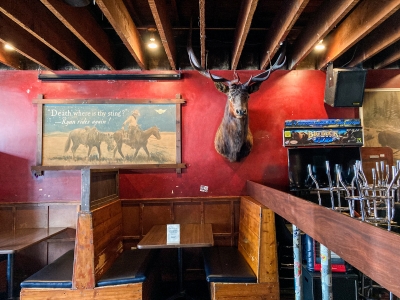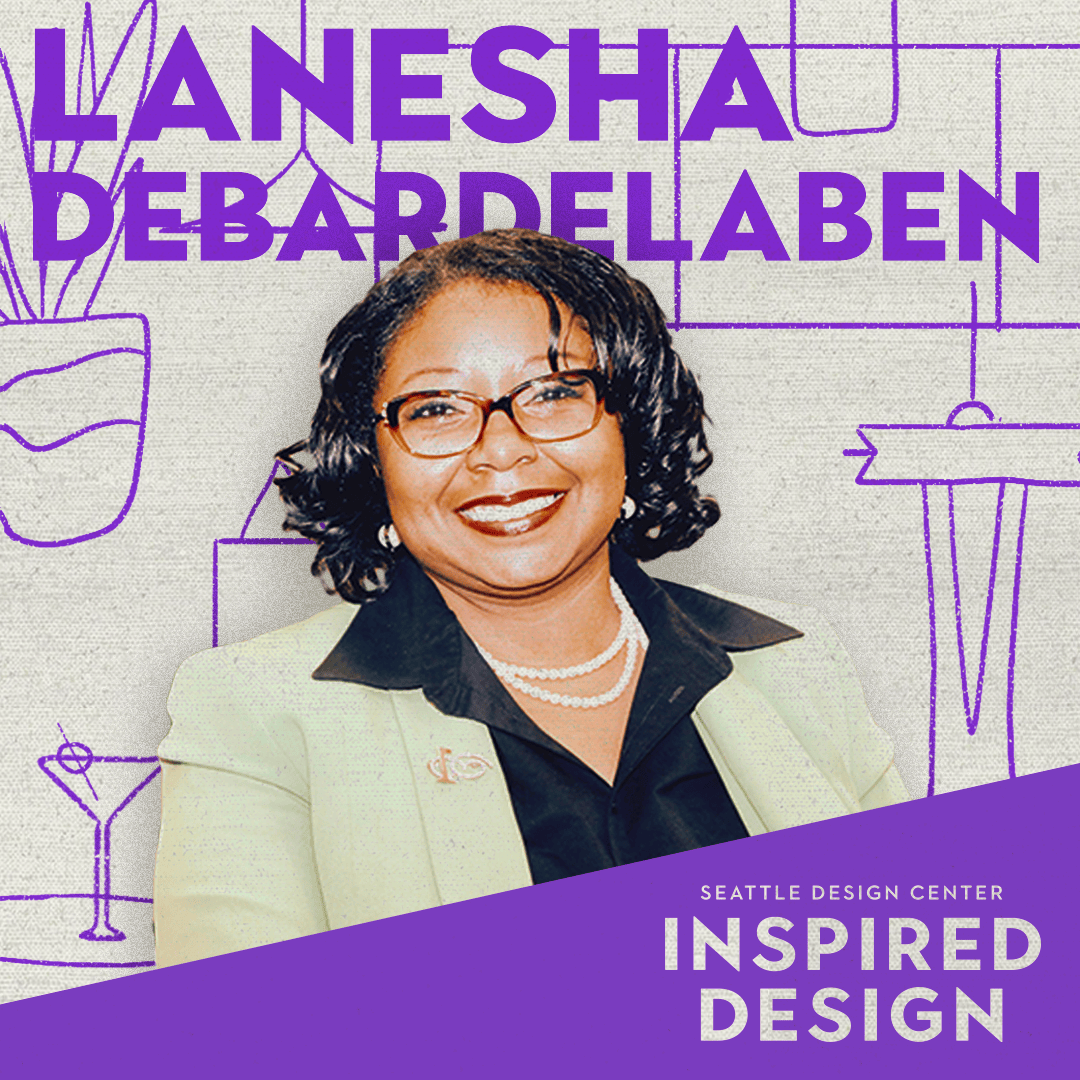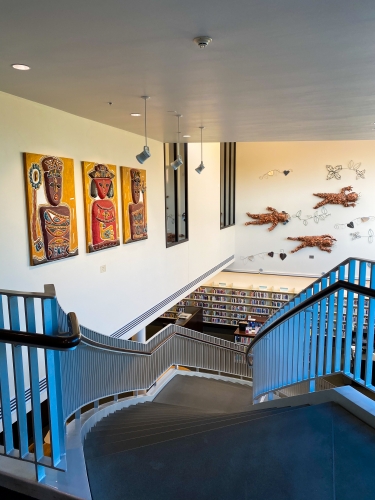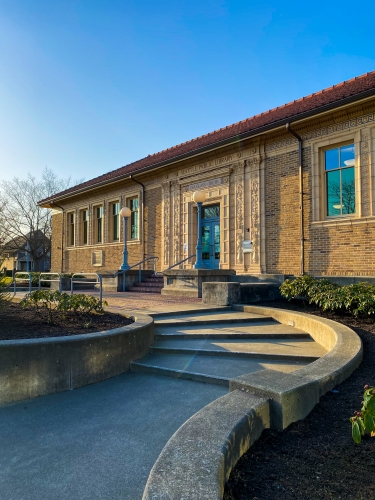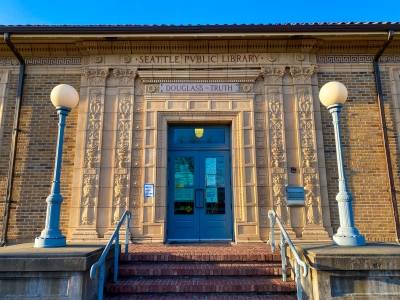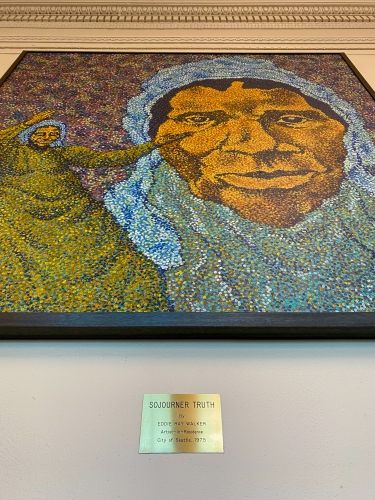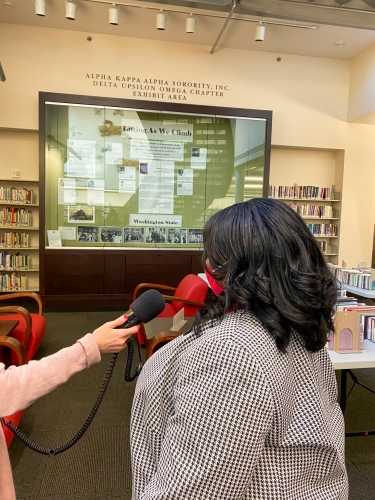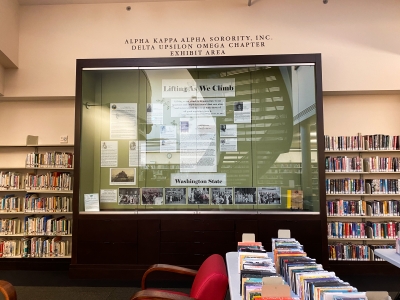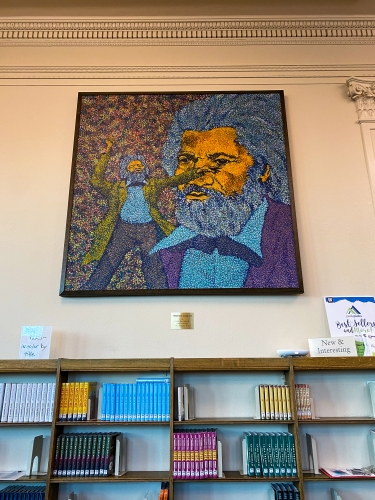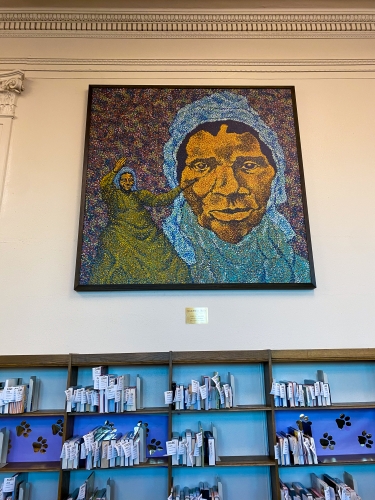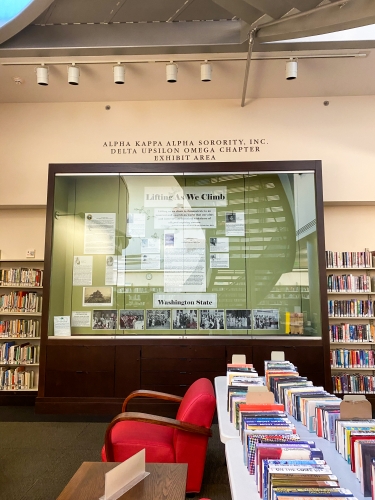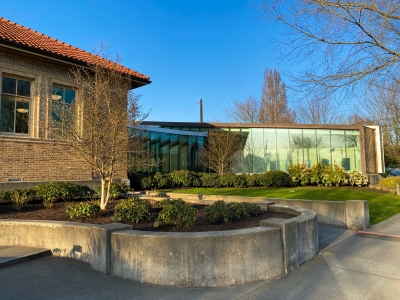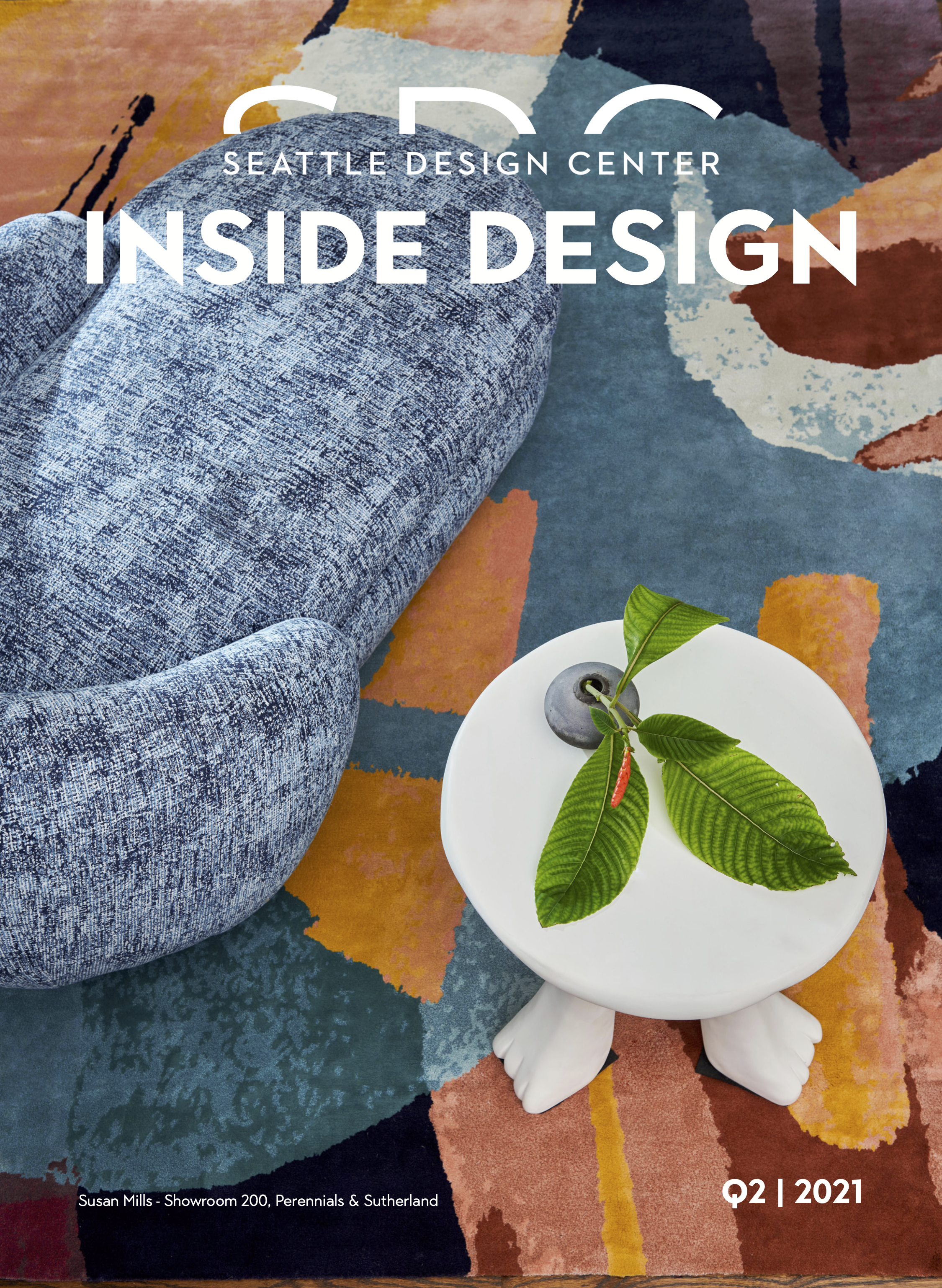Matthew Craig Interiors is a high-end, boutique Interior Design Studio. We help our client’s by capturing their unique spirit through an artistic and sophisticated lens. With over 15 years of experience, we’ve worked on everything from residential remodels and new construction, to restaurant and hospitality designs.
Kirsten Conner
KIRSTEN CONNER
Award-winning interior designer waging design battle on the gray skies in the Pacific Northwest. I collaborate with color, light and texture to transform your home beyond what you thought possible.
Everett Fitzhugh | Keeping it Kraken
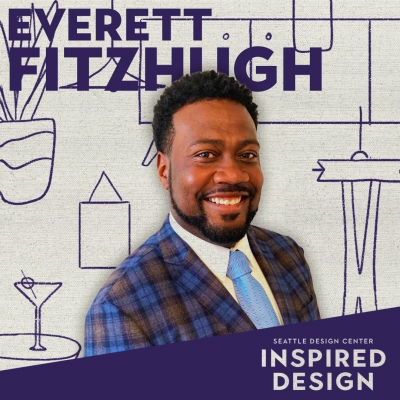
Everett Fitzhugh | Keeping it Kraken
In this episode of Inspired Design, let NHL announcer, Everett Fitzhugh’s contagious energy and passion for the future seep through your speakers and into your ears. You will be transported to the new Climate Pledge Area and get an endearing glimpse into why Everett is so proud to make history with The Seattle Kraken!
Explore this Episode
Episode Transcript
Everett Fitzhugh:
I’ve got a lot of energy, and I’ve got a lot of passion, and I have a lot of volume when I speak. Like my goal call, “He scores!” It’s a very deep goal call. So you do that enough time, I guess your voice gets used to it, but,
Gina Colucci:
But I’m Gina Colucci with the Seattle Design Center. Every week on Inspired Design, we sit down with an iconic creator in a space that inspires them.
Everett Fitzhugh:
So many people speak with such reverence of the old Key Arena. Then you preserve the history of the building, the iconic historic roof that is still there,
Gina Colucci:
I had the chance to meet Everett Fitzhugh at the Climate Pledge Arena Preview Center. Everett is the Kraken’s first play-by-play announcer, and the first full-time Black broadcaster in NHL history.
Everett Fitzhugh:
I hope it tells that nine-year-old Black kid in south Seattle that you belong in this game. There’s a place for you.
Gina Colucci:
He became a hockey fan as a kid.
Everett Fitzhugh:
The culture of hockey is something that I fell in love with.
Gina Colucci:
But got his first taste of NHL broadcasting in 2018.
Everett Fitzhugh:
As a play-by-play announcer, I’m following the puck. He may be looking,
Gina Colucci:
When I caught up with Everett. Hi.
Everett Fitzhugh:
Hi.
Gina Colucci:
Nice to meet you.
Everett Fitzhugh:
Nice meet you, as well.
Gina Colucci:
His excitement about all things Kraken was palpable.
Everett Fitzhugh:
Welcome to our Preview Center.
Gina Colucci:
Thank you for having us.
Everett Fitzhugh:
Yeah, this is going to be a lot of fun. I know that we’re so close to opening our building, and I want to show you what everybody can expect. So, let’s take a walk through our model room, here.
Gina Colucci:
Let’s go. Wow.
Gina Colucci:
Everett opens the door to this preview area, and it’s almost like you’re walking up a ramp into a movie theater. Along the wall of the ramp are all these historical photos of famous people and artists who have performed at the arena.
Everett Fitzhugh:
There’s been so much foot traffic through this building, and so much excitement through this building. And we really have captured the history of Seattle, of Seattle hockey, of the building. A lot of people don’t know the very first American team to win the Stanley Cup were the Metropolitans back in 1917.
Gina Colucci:
No way.
Everett Fitzhugh:
Yeah. So,
Gina Colucci:
I’m one of those people who had no idea.
Everett Fitzhugh:
So it’s going to actually be really, really cool, because our second home game is against the Montreal Canadiens, who the Metropolitans beat. So it’s going to be Montreal’s first trip back to Seattle in about 106 years.
Gina Colucci:
Wow. That’s history.
Everett Fitzhugh:
Yeah,
Gina Colucci:
That is making a [crosstalk 00:02:35]
Everett Fitzhugh:
Just got goosebumps thinking about it, right?
Gina Colucci:
Yeah.
Everett Fitzhugh:
So we’ll come around the corner here. This is going to be a world-class music venue, live events, family shows. This is going to be a place for our community to come together. So you see Elvis has been here. You see the construction of the Space Needle for the World’s Fair. You see the construction of the original building. You’ve got a Sonics jersey from back in the day. Jimmy Hendrix, all of these amazing people who’ve come through this building. And, of course, you’ve got the Storm. This is going to be their home, too.
Gina Colucci:
Yes.
Everett Fitzhugh:
The four-time WNBA champions, Seattle Storm. So,
Gina Colucci:
Let’s go.
Everett Fitzhugh:
Yes. So there is just so much history that’s going to be in this building. I think it gets lost sometimes, that obviously we, as the Kraken, and the Storm are going to be the primary tenants, but we’re looking to have 150 nights a year, 200 nights a year of events, of live entertainment. And it goes way beyond hockey.
Everett Fitzhugh:
So then we’ll stop right here. And this is something that I’m really, really proud of. I get goosebumps seeing this every time. I’ve probably seen this about 20 times now, and I still get goosebumps. So I’m going to play a little show for you guys, here. And you guys are going to really get to feel and see and hear just what is going to happen with the opening of this arena and the announcement of this team.
Video:
Clearly, the people in Seattle want a team.
Video:
A massive [inaudible 00:04:09] of sports fans in Seattle.
Video:
Their goal is to get 10,000 deposits over a six-week period.
Video:
They got 10,000 commits in 12 minutes.
Video:
No expansion team in the history of sports has done this.
Video:
The rest of the hockey world took notice.
Gina Colucci:
This is the ultimate hype video of hype videos. We were standing there, and Everett presses play, and you can just feel the excitement and the drama and how much this team is going to mean for Seattle. Beneath it was this full model of the Climate Pledge Arena. And as the video progressed, and got more excited and loud, the arena started to light up in different places, til ultimately the roof of the model lifts off. It’s like, there’s fireworks going on around the arena, and you can see the court start to light up in the middle, and the seats, and they have audio of the crowd cheering. It just shows you how much thought and purposeful design went into the redesign of this iconic building.
Video:
We’ll bring the Stanley Cup back to Seattle. Let’s go, Kraken!
Everett Fitzhugh:
You know, I’m not from Seattle, but I know so many people speak with such reverence and they speak with such fondness of the old building, the old Key Arena. Right? And then, to have it shut down for a couple of years, but then you preserve the history of the building, the iconic historic roof.
Gina Colucci:
A relic of The 1962 World’s Fair, the Washington State Coliseum, more commonly known as the Key Arena, was recently designated a historical landmark. It was designed by Paul Thiry, the fair’s principle architect, who intended for the building to become a sports arena after the fair. The landmark designation means that the interior can under undergo renovations, but the exterior must be preserved.
Everett Fitzhugh:
We actually were able to put the roof on temporary stilts and supports for over a year, about two years, actually. And we dug out. We built up. Now, when you come in, you actually enter the arena on the main concourse level. So you’re actually going down to your seats. If you’re in the lower bowl, as opposed to a lot of other buildings, you have to go up to [inaudible 00:06:50] place. So you actually enter probably right around on this level here. If you have seats in the upper bowl, it’s not that far of a hike for you to get to your seats. So that’s one thing that I think is a little bit unique and a little bit different compared to other buildings.
Gina Colucci:
So why the Climate Pledge Arena name?
Everett Fitzhugh:
The building is going to be natural gas free. It’s going to be aiming to get rid of single-use plastics by 2024. Our historic roof is going to collect rainwater in these massive cisterns. And that’s going to be used to resurface the ice. We’re sourcing, I think, 80% of our food. We’re sourcing that from within 200 miles of Seattle. One of the coolest things that I’d learned is how our game ticket doubles as a transit pass. So you scan your game ticket, you can take the monorail, you can take the bus, you can take public transportation down to our game, helping to limit that carbon footprint.
Gina Colucci:
That is absolutely amazing. Because now the Ravenna Station, Northgate, and then they’re going to keep going north. So you can use your ticket,
Everett Fitzhugh:
[crosstalk 00:08:02] pass, yep.
Gina Colucci:
on the light rail. So you could get from your practice rink [crosstalk 00:08:06]
Everett Fitzhugh:
That’s what I plan on doing. So I actually plan on parking at Northgate, and then taking the train down to games, and then hopping back on the light rail and going home. The amount of attention that’s being paid to sustainability, limiting that carbon footprint, is something that no other building in the league, in the world, really, is doing. And to be able to work here and to be a part of it has been awesome.
Gina Colucci:
That’s amazing. And do you know how many actual seats there are?
Everett Fitzhugh:
17,100 seats for hockey. I believe 18,300 for basketball. And then, depending on the concert configuration, anywhere from about 15,000 to 16,000.
Gina Colucci:
That’s amazing. And then I can see you’ve got, these are boxes?
Everett Fitzhugh:
Yeah. So this is actually our press bridge. I will actually probably be right in that press box, right there at center ice. So that’s going to be our press bridge. And then we have a ton of amazing premium areas. And I can actually pull up some of these right now. So you have the sideline suites that are going to be mid-level, all of our shows, all of concerts, for a Seattle Storm game. Can you imagine washing the WNBA from one of these areas? One of my favorite views of this lounge is actually going to be our Space Needle Club, which, when you’re inside the Space Needle Club,
Gina Colucci:
Nice.
Everett Fitzhugh:
You’ll have the Space Needle right there.
Gina Colucci:
I mean, that just stunning, because I’m sure, you know, this is a render. However, when you’re standing in at the bar, you’ve got a great view of the rink,
Everett Fitzhugh:
Yeah.
Gina Colucci:
and then above you is just this skylight,
Everett Fitzhugh:
Yeah.
Gina Colucci:
that highlights the Space Needle. And then you’ve got a window, I’m guessing, then that’s the Chihuly glass.
Everett Fitzhugh:
Yeah.
Gina Colucci:
And it’s just absolutely beautiful. And the materials. I can’t wait to see it.
Everett Fitzhugh:
My goodness.
Gina Colucci:
I cannot wait.
Everett Fitzhugh:
It’s going to be awesome. And then, again, we’re talking about design, this is another feature that is seen a lot in NHL buildings now. You have tunnel clubs when players come out of the locker room here.
Gina Colucci:
Oh wow.
Everett Fitzhugh:
You’ll have suites on either side of that glass there. So as they’re walking down the tunnel, and again, this is obviously an animation here. So this isn’t going to be what ours will look like. But that’s essentially going to be what you’ll have. You’ll see players walking by as you’re sitting in there enjoying a cocktail, enjoying some dinner, or whatever the case may be, again, right there. You’re in there. And Chris Driedger’s reporting for work tonight, and he’s walking right past the tunnel club, and fans are going to be able to see that. So just different ways to bring our fans and our guests closer to the action and to our players.
Gina Colucci:
That’s really cool. Talk about blending such a great sport with luxury. They’ve really thought about every level of fan and,
Everett Fitzhugh:
And you know what? That’s sports today. That is sports today, because, you know, I just got back from Boston, and I went to a Red Sox game, and I’d never been to Fenway before. And it was cool being in Fenway. It’s very uncomfortable. The seats are tight. That building was built for baseball. You go, you watch the baseball game, you go home. Nowadays, when you are going to a basketball game, a football game, you go into a Seahawks or Mariners or a Kraken game, it’s an event. It’s not just the game, it’s an event. So you’re going for dinner. You’re going to have a couple of drinks. It’s a social event. So going to sports nowadays, and really over the last 20 years, 25 years, with the advent of all of these new stadiums, luxury and comfort and an event is at the forefront of a lot of designers’, owners’, front offices’ minds. That’s where they want to live. They want to be able to have our fans and their fans and customers come in and be comfortable and enjoy things that they may not otherwise get to see.
Speaker 4:
Seattle Design Center is the premier marketplace for fine home furnishings, designer textiles, bespoke lighting, curated art, and custom kitchen and bath solutions. We are located in the heart of Georgetown, open to the public Monday through Friday, with complimentary parking. Our showroom associates are industry experts, known for their customer service. We are celebrating new showrooms and added onsite amenities. Visit seattledesigncenter.com for more information about our showrooms and our Find a Designer program.
Everett Fitzhugh:
When I found out that we had sold 32,000 season ticket deposits, and we did 12,000 of those in 10 minutes, it’s just remarkable how well this community and this city has responded to this team and to this organization and to this venture.
Gina Colucci:
Yeah. And what does that feel like to be a part of that, to be the first announcer, in that he’s going to announce from the Climate Pledge Arena and have that community around you?
Everett Fitzhugh:
Man. It’s really cool. I’ve been thinking about that for the last year, what that will mean, what that will feel like. And it’s hard to put into words, because I’ll get goosebumps, and I’ll get that, you know, when you got a big presentation coming up, you kind of get that butterfly, slightly nauseous feeling. I get that sometimes just thinking about that first game, what that’s going to look like, what that’s going to sound like, and smell like, and feel like, and I think, ask me on that day.
Gina Colucci:
Yeah.
Everett Fitzhugh:
Ask me,
Gina Colucci:
I was going to say, I was like, can we go and sit down and can we walk through your first game?
Everett Fitzhugh:
Yeah.
Gina Colucci:
Would you be comfortable?
Everett Fitzhugh:
I would be very comfortable with that.
Gina Colucci:
Let’s have fun with it. Okay. Okay. Ready?
Everett Fitzhugh:
Yeah.
Gina Colucci:
So you’re walking into the arena.
Everett Fitzhugh:
So I’m walking, I’m walking into the arena, and my first thought, I’m looking around and I’m just like, man, this building is amazing. They always tell you, act like you’ve been there before, but I can’t help but take out my camera phone. I’m going to take some photos of the building. I’ll find the press elevator. I’ll go to my press box. And then I’ll get there early. So the game’s at seven, I’ll probably show up at about four. So I’ll get there early. I’ll go to the press table, and I’ll sit down, and I’ll feel the countertop. And I’ll look. I’ll just stop, I’ll put my bag down on the chair, and then I’m just going to look at the ice. I’m going to look at the ice. I’m going to look at the building. I’m going to look at all the seats. And my wife and her sister are coming. So I’m going to try to find their seats. I put them right across from me, so I’m going to be able to see them. So I’m going to find them.
Everett Fitzhugh:
Then my color analyst is going to walk into the building, and then I’m going to meet him, and we’re going to go over our game plan for the day. I’ll probably go downstairs, grab a media meal, maybe some last comments from our coach, then come back upstairs for pre-game warmups. You’re going to hear the sticks and the pucks and the skates. For the first time in this building, hearing all of those sounds that make hockey so romantic. You’re going to hear those in Seattle for the first time in over 100 years. Then our entertainment team has done an amazing job. So they’re going to be putting together an awesome pregame show, light display, all types of sounds and videos and pictures. You’re going to have the introductions. You’re going to hear both anthems, both the US and Canada, because we’re playing Vancouver. And then the puck drops, and then they let me off the leash.
Gina Colucci:
What is, when that hook drops,
Everett Fitzhugh:
Yeah.
Gina Colucci:
what do you feel?
Everett Fitzhugh:
I’m I’m already like, people have asked me that question. “So do you know what you’re going to say? Do you have a script?” And I’m like, I can lie to you and say I do, but it’s one those things where you can’t script that moment. You can’t write down, “Good evening, ladies and gentlemen, welcome inside Climate Pledge.” It’s not a normal game. It’s something much more. So I think I’ll have some bullet points. I’ll have an idea of what I’m going to say in that opening. But when the puck drops, you just, you go with what you feel. I’ve been doing this for 13 years, and I like to think that I’m going to be able to find the right words to capture that moment. I may have a backup script, just in case, but might drive my wife crazy, because I’m like, “All right, how does this sound? Listen to this.” She’s like, “You’re fine.” Like, “I don’t know. Let’s do it again. Run through it again.” But, no, it’s going to be a very surreal moment.
Gina Colucci:
You know, you use your voice. That is your tool. And you’re coming in, and you are live. When you sit down, it’s green light, go, and there’s no editing going back like this. Can you walk us through what it’s like to prep?
Everett Fitzhugh:
Calling the game is easy, because you see what’s happening. Right? My job is to tell you, “He brings the puck over the blue line, he shoots and scores.” That’s my job. That’s the easy part. The hard part is knowing your players and knowing your subjects. And for me, it is all about storytelling, and finding ways to connect these players to our fan base, to our community. This is a town that hasn’t had the NHL in over 100 years. So you’re now bringing in 23 new bodies, 23 new athletes who literally hundreds of thousands, maybe millions of people are going to be invested in. Think about that for a second. So, telling stories of guys who just got married this summer. I was talking to one of our goalie the other day, and he’s a new dog dad. His girlfriend’s finishing up school in Boston. So the dog is actually with the girlfriend. And he’s like, “I kind of miss my puppy right now.” And it’s just, things like that that will connect you with our players.
Everett Fitzhugh:
Names and numbers and stats, that’s the easy stuff. Because, as a hockey person, you know goals and assists and how does this player play. But I want to go deeper than that. At the end of the day, it’s more than just the power play. It’s more than just how many goals he scored. It’s who is Player A as a person? What do you like to do? We have a number of players on our team who are involved in multiple charities related to mental health, and mental health has gotten a huge boost, especially in the hockey world, over the past five to 10 years. So they have now started, a couple of our guys have podcasts, and they have charities that they work on that are dedicated to mental health and improving your mental health. Those are the stories that I want to tell.
Everett Fitzhugh:
We have a pair of brothers on the team, Cale and Haydn Fleury, and then Brandon Tanev’s brother, Chris, plays for our rival in Calgary. So they’re going to play each other twice in preseason and then four times in the regular season. So, what’s it like going up against your brother? What’s it like having two NHLers from the same family? I mean, let alone more than that. So there are just so many amazing stories to tell about our players, and I think that’s where a lot of the prep work comes in. Obviously, you want to prepare for the game and calling play by play, which, again, that’s where my passion lies. But I also love telling stories. I want our fans to feel as close to our players as I am through that storytelling.
Gina Colucci:
Another important dynamic Everett is thinking about is the one between himself and the team’s color analyst.
Everett Fitzhugh:
So the relationship between the play-by-play announcer and the color guy is a really cool one across all sports. Right? I’ve actually been my own color analyst. I’ve been my own producer. I’ve been my own intermission host for the last seven years when I was in my various stops. So the fact that now I have an NHL color announcer in Dave Tomlinson, who’s been doing this with Vancouver for so many years, former player in the NHL, he brings such a unique and different perspective. I think having a color analyst is twofold. Number one, it gives me an opportunity to shut up for a bit, because, contrary to popular belief, not everybody wants to hear me all the time.
Everett Fitzhugh:
Number two, more importantly, I think what having a color analyst does is it allows that person to bring in a perspective that I’ll never have. No matter how much I study hockey, no matter how many games I watch, no matter how many people I talk to, I’ve never played the game at a high level. I played a couple of scrimmages and shinny league games and whatever. I don’t know what it’s like being in the locker room, being in an NHL huddle. He does. So bringing that element and that viewpoint, I think is huge. And it also just brings different viewpoints, because there may be things, as the play-by-play announcer, I’m following the puck. He may be looking behind the play and see something completely different. “Where’s number five? He’s not on the ice right now.” “Well, the puck was in the corner, but I saw him go long.” That position, as an analyst, the analyst brings a different view and a different way to see the game.
Everett Fitzhugh:
I think some of the best broadcasters and some of the best play-by-play announcers are the ones who can have that relationship with their color analysts. When I called him, I said, “Listen, this isn’t a business relationship. We’re going to be friends. I want people to feel that we have fun, that we- ‘wow, these guys are at a bar having a beer right now.’ That’s what I want.” I want it to feel as if we’re having a conversation. Me, him, and our thousands of best friends listening to us calling a game, talking with us calling a game.
Gina Colucci:
That sounds so much fun. I cannot wait,
Everett Fitzhugh:
Oh, yeah. Oh, yeah.
Gina Colucci:
to tune in and be like, “Oh!”
Everett Fitzhugh:
I’m so excited. I’ve been looking forward to this for so long. And having been on staff now for a year, and seeing all of the strides that we’ve made in so many departments, now that it’s finally here, oh my goodness. It’s amazing. It’s absolutely amazing.
Gina Colucci:
That’s some prep work.
Everett Fitzhugh:
Oh, yeah.
Gina Colucci:
Yeah.
Everett Fitzhugh:
Oh, yeah.
Gina Colucci:
You have been prepping for it.
Everett Fitzhugh:
I have been prepping for it. Don’t worry.
Gina Colucci:
You don’t want to,
Everett Fitzhugh:
Yeah. I have been prepping for it, but, like I said, you know the players, you know their story, but the canvas is blank, and you have to paint it. For me, painting is the easy part. It’s getting all the colors mixed before, that’s the hard part. But once I have everything mixed, the painting’s easy.
Gina Colucci:
One last question. What was it about hockey? What kept you there?
Everett Fitzhugh:
You know, I remember that first game, and going into the press box, and you saw everybody’s in suits. They’re impeccably dressed. And it’s a very corporate, serious atmosphere. And I was drawn to that. You know what I mean? Everybody had a job to do, everybody was serious, but you could tell that they were having fun doing what they were doing. The culture of hockey is something that I fell in love with. I think it’s so unique. And I wanted to be a part of that culture.
Everett Fitzhugh:
I also wanted to be a part of trying to help change the culture of hockey. Growing up, I didn’t have a lot of people who looked like me playing and working in the sport. And that’s how I got into the game. I saw two Black players on the same team. For me, that was huge, because, historically, hockey has said that there isn’t a place for Black men, for women, for other minorities within our game. For me to be able to be a part of the hockey culture, and then work to change some pieces of that hockey culture, that’s why I wanted to stick with it. I mean, there have been plenty of times when I could have given up. You hear things, or you’re in the minors and you’re pulling into this city again for the umpteenth time at three o’clock in the morning, humping bags and unloading dirty pads, and you’re just like, “Man, do I really want to keep doing this?” But this is the payoff, being a part of something great and part of something huge. That’s what kept me going.
Gina Colucci:
Now that he’s in the NHL, I asked Everett, what will keep him going in this next phase of his career?
Everett Fitzhugh:
I want to be somebody who did everything they could to tell Black boys and girls, Hispanic boys and girls, Asian boys and girls, the growing number of women and young girls playing the game, I want them to know that you belong in the game of hockey. You can play hockey. You can be a fan of hockey. You can work in hockey. You can buy hockey jerseys. Just because I’m a Black man, I’m not beholden to basketball and football. That’s what I was told as a kid growing up. “Oh, yo, you play hockey? He must be a White boy.” Oh, I played baseball rather growing up. “Oh, wow. You know, Black folks don’t play hockey. Why don’t you play basketball?” And I was like, “Because I want to play baseball. I’m a baseball player. I like hockey. I’m a hockey fan.”
Everett Fitzhugh:
So I want to get rid of all that. And for me to be able to do this is huge because, like I said, I didn’t have a lot of those positive Black influences within the game of hockey to look up to. So if I can be that for someone else, and if there’s a kid who, in 20 years, 30 years, hopefully he’s in the broadcast booth next to me.
Gina Colucci:
Inspired Design is brought to you by the Seattle Design Center. The show is produced by Larj Media. You can find them larjmedia.com. Special thanks to Michi Suzuki, Lisa Willis, and Kimmie Design for bringing this podcast to life. For more, head to seattledesigncenter.com, where you can subscribe to our newsletter and follow us on social media. Is there an iconic Northwest creator that you want to hear from? Head to our website and leave a comment.
Heidi Caillier
HEIDI CAILLIER
Heidi Caillier Design is a full-service interior design firm based in Seattle, experienced in everything from new build construction to simple room refreshes. Our expertise lies in full-scale renovations and full-house furnishings. We work closely with architects, builders, contractors, furniture makers, and artisans to create unique spaces that are client-friendly and speak to your specific needs.
Our design philosophy is based on the belief that homes should be comfortable and livable while at the same time beautiful and curated. Our style mixes old with new, integrating textures and color, layered with pieces that feel travelled and have history. An intrinsic love of vintage furniture and materials that feature raw and natural textures balance our appreciation of color and pattern to create spaces that feel practical and effortless.
Tom Douglas’s Curated Kitchen
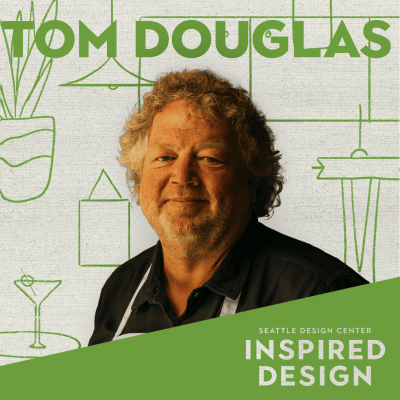
In this episode of Inspired Design, famed chef and restaurateur Tom Douglas gives us an in-depth tour around his eclectic home kitchen and yes, also his bathroom. We learn why it is essential to share your spirit when designing and how flow and function are a major priority for any kitchen.
Episode Transcript
Gina:
I’m Gina Colucci, with the Seattle Design Center. Every week on Inspired Design, we sit down with an iconic creator in a space that inspires them.
Tom:
Somebody walks into your restaurant, you want to share who you are with them and what your idea behind the restaurant was, pretty quickly.
Gina:
You can’t talk about Seattle’s food scene without mentioning Tom Douglas. Tom has been making food in Seattle for 35 years. He opened his first restaurant, Dahlia Lounge in 1989. From there, he launched more than a dozen other enterprises and has received three James Beard Awards, including Outstanding Restauranteur in 2012. His imprint on the city and the entire Pacific Northwest is unmistakable. He helped put Seattle on the map as a food destination. I got the chance to catch up with Tom in his home kitchen, where his mark on the space is immediately recognizable.
Speaker 3:
Hello.
Speaker4:
Can we come in?
Tom:
No.
Gina:
We meet his business partner and wife Jackie, and learn how they built their kitchen from the ground up.
Speaker4:
Thank you for having us.
Speaker 3:
Yeah
Tom:
Pleasure.
Speaker4:
Inviting us in.
Tom:
When we first moved into this house about 22 years ago now, [crosstalk 00:01:17] maybe 23, 24. Well, the first day we walked in, the mountains were crystal clear out in the mountains[crosstalk 00:01:24]November. Now you can only see half of them, but it always reminds me of that day we walked in here [crosstalk 00:01:31]and then we couldn’t afford the house. We did it anyway.
Speaker4:
Do you want to give us like a little verbal tour?
Tom:
I guess the question is there’s design; there’s function; there’s flow, and so when I go through it, I guess I speak to that because in the restaurant business, on the hotline, it’s all about fluff, right? And design is a little bit different. Because design, like you have to decide, do you want to commercial looking kitchen? Do you want a home-style kitchen? I kind of went both ways with that, but flow is number one. It’s like when you’re standing at the stove and you need hot water, or you need something from the fridge or you need to get to your cutting board, how does that work? How does that feel? And are you running back and forth through your kitchen or is everything just at your fingertips?
Tom:
And then the restaurants, each station is set up for a flow for that station and for what dishes come off of that station. So it’s kind of set up so that it’s at your fingertips, everything right there. And then in the restaurant, like you see my stack of saute pans, things like that.
Speaker4:
Yes.
Tom:
A pan like this, I just said a 12 inch saute pan or 10 inch saute pan. I might use this three times a week at home. I’ll use this 300 times a night at the restaurant. And so it’s just a different thing, and I have high expectations and I still have some of my original pans, 25 years later at Palace Kitchen of this All-Clad nice heavy pan. So some people might consider that design, because it’s a fancy looking pan. But to me it’s useful.
Speaker4:
Mm-hmm (affirmative).
Tom:
How does it function? So form and flow and function are huge issues in my kitchen.
Gina:
When you walk into their house, you’re immediately struck by the amazing view of the Olympic mountains. And then as you turn the corner, you’re in the kitchen and this kitchen is exactly what a professional chef would want. It is dialed in. It’s not a minimalist kitchen. We’ll put it that way. His kitchen is filled with everything that he loves, and there’s very little counter space left, but everything has a purpose.
Tom:
You can see everything’s kind of out and about. You might see in a restaurant, pan racks. My knives are all lined up ready for me to grab. Everything’s kind of out and about, but at the same time, I got nice wood shelves and hold up all my cutting boards and my big pots in the lids and things that you would never see in a restaurant. So that’s kind of a baseline of what I tried to do.
Speaker4:
You mentioned you bought this on 25 years ago.
Tom:
Yeah.
Speaker4:
Is this what the kitchen looked like?
Tom:
Are you kidding me? Your back is to the kitchen right now when we bought it. If you turn around, there was a shelving unit that came off the fireplace here. And so the stove was right there and the refrigerator was over here. It only had a four seat dining room. And so we just need more, we entertain a lot. And so we needed more space. So we took the kitchen and dining room, combine those, then took the TV room and made a kitchen out of it.
Tom:
And then this over here, now that’s commercial. If you look in here, I have a two minute cycle dishwasher. So every two minutes it goes through a whole load. And then I have a spray nozzle that you see in every restaurant kitchen. But I have it tucked away because I’m entertaining over in my dining room, and I didn’t want to see that in my kitchen. So I have this tucked around the corner and there’s a big enough place to drop all the dirty dishes. So you don’t have to do it till later, but that’s what that is.
Speaker4:
That looks really convenient.
Tom:
Yeah. And when you entertain a lot, it is convenient. I can tell you, I can do dishes for a party of 30 in an hour.
Speaker4:
Well, then no wonder you entertain.
Speaker 3:
Yeah.
Speaker4:
That’s the best biggest way. And I want a little bit more insight on this island because walking into what used to be your TV room is now your wonderful kitchen. This island here is a very substantial part of it.
Tom:
Mm-hmm (affirmative).
Speaker4:
And so what was the reasoning and the shape?
Tom:
It looks like a baseball diamond. Honestly, if you look at interior of a baseball diamond, that’s what it kind of looks like, but it’s actually very functional.
Gina:
The kitchen Island is on wheels and you can push it to the corner of the kitchen, which shakes this professional prep kitchen and turns it into an amazing entertainment space.
Tom:
Around the island. I have large drawers. Each drawer is kind of dedicated to an area of service. So I have a whole baking drawer there. I have a pasta and starch drawer over there. On this side I have all my bowls in the bottom one and all my stuff like saran, rapid gloves and stuff like that in another. The top was intended that at the time when we built it, we didn’t have Hot Stove Society or cooking school. And we would often new classes and donate classes. And so I made it so that I could get nine people around this island, and I was the 10th, so groups of 10 we could do a cooking class together.
Tom:
And then we put it on wheels, which is unlike most islands. And if you look at the shape of the island, it fits right back into the corner there. So that when I have a party, I will put all the buffet out here, shove the island, then back when I’m done cooking and the lights go right over top of the buffet then. And so it’s well lit and it opens up this room for more traffic.
Tom:
And of course you can see the big hole in the island too. That was featured on the Oprah Winfrey Show. But yeah, that’s just a simple little garbage.
Speaker4:
Well, yeah. I was like, there’s a hole on it. Did you know that? And so speaking, I mean, you’ve mentioned that you have parties and you entertain. Is that a source of inspiration for you?
Tom:
Perspective, absolutely. There’s a couple of things that go on there. One is I had 15 restaurants, right? And so I’m always thinking about new menu items, this and that. Maybe a new restaurant, this and that. So I keep a set of china from each restaurant here. And so if you look on this wall over here, I have maybe a dozen sets of china over here and I have more in the garage so that when I played something that I’m dreaming up for Lola, I can put it on a style of plate that matches Lola’s food and thought process.
Tom:
And that’s kind of why I do that. Plus there’s just fun to have. And then on the platter side down there, I have a whole collection of platters and I try to buy one, when we travel around the world, we try to buy a platter from each place as a memento so that when we’re passing around the table, it’s a conversation piece.
Speaker4:
Oh, shot glass.
Tom:
Exactly.
Speaker4:
So, I mean, going back to the different plates, would you say that each one of your restaurants obviously has its own personality? Is that part of your creative process? Do you kind of think of your restaurants as maybe people.
Tom:
Not necessarily people, but individual places, yes. I sure do. And they end up taking on my personality, Jackie’s personality. They end up sometimes if a chef has been there long enough, they’ll take on the management personality, especially in the service side of things. And it’s a gentle way to share your spirit, right? When you think about it, it’s like when somebody walks into your restaurant, you want to share who you are with them and what your idea behind the restaurant was pretty quickly.
Tom:
You don’t want it to be something that they have to come back six times for it. You want to kind of show that right away. And that comes across in the light fixture that you choose and the color of paint that you choose. And it comes across in your access to visual with the kitchen, like serious pie. I always wanted everyone to be able to see the wood fire in the oven. When I set up the dining room, I kind of worked it so that every table could see the wood fire. And so that was an energy that I wanted to bring to that customer. And just an immediate, oh my God, that looks delicious, or fire, people love fire.
Speaker4:
Mm-hmm (affirmative).
Tom:
Some people love it a little too much. They’re called pyromaniacs.
Speaker4:
Don’t we all? I know a few of them were past child. What would you say or which restaurant hits closest to your own personality?
Tom:
I don’t really think about it. Probably this kitchen does more than any of the in particular restaurants, I would say, because of the functionality of restaurants like Dahlia Lounge has 170 seats. You can’t get anywhere close to what you might do here, because you have to service a lot of people all the time, three meals a day, seven days a week.
Tom:
From the menu was probably more close to what I would relate to than the restaurant itself. And I would say that all of them are a moment in my time at Palace Kitchen, probably the closest if I’m in another city and I’m going out for one or two meals and I’m in a hotel, or on business, and I want a sense of place. I look for a place that has windows. I hate places that have no visuals to the outside world that you don’t know if you’re in Seattle or Paris. I hate that. So I looked for a place that has windows, activity and gives me a sense that if I’m in Seattle for two nights, that I’ve been there; that I didn’t miss a thing.
Speaker4:
So I want to touch back too on, you said, the menu is kind of closer personally to you,
Tom:
To my personality.
Speaker4:
Yeah, to your personality. Can you walk us through what it’s like for you to create a menu through that process?
Tom:
Yeah. You never know Where it’s going to come from. That’s so funny. We’ll take Lola for example, Jackie’s grandfather immigrated from Greece when he was 17, married a woman from Kentucky in Eastern Washington when he was working on the railroad and never had a chance to go back. She wasn’t interested and he just never had a chance. And one time when we were at Dahlia, I don’t remember why it happened, but we did a Grandpa Louie’s Greek vacation, dream Greek vacation plate. And it was just I did some Greek things, because I was in the mood for that or whatever. And so out of that came my book Tom’s Big Dinners. And so we took that one step further and made it like a five course meal out of that. And out of that big dinners came Lola, the restaurant, because we love that chapter, and we love the energy of that chapter. And we loved that she’s part Greek, and that word has a story all of our restaurants, so need to have a story behind them why they’re there. So I love that about it.
Speaker4:
Did you get to meet him?
Tom:
I never did meet Louie. No, never did. Jackie just was so embarrassed by me that she never took me over to him. Was Louie even alive when we met?
Jackie:
He was long passed.
Tom:
He was dead. Louie is dead to me. [crosstalk 00:12:55]
Gina:
One thing that surprised me, Tom is quite the collector. And we got a tour of his favorite treasures sprinkled throughout the kitchen.
Speaker4:
Little bus or what would you call them? Faces?
Tom:
I think they are. I have a $5 dough right here. The jar spice rub with love spice rub, if you can tell me what they are.
Speaker4:
Well, they all have a hole in their mouth.
Tom:
Yes, that’s true. Those are butcher string holders.
Speaker4:
I would not have guessed that. [crosstalk 00:13:23]
Tom:
I know you wouldn’t. So if you look at them in the back, they’re hollow and a ball of butcher twine fits in there, and you hang this in your kitchen and the twine comes out, so when you need to put your string, you just pull on it. I collect now post-World War II, Chakra Wear, vintage.
Gina:
Chakra Wear got it started in the 1800s, as a cheaper and more accessible alternative to ceramics coming from Europe and China by boat. The pieces were made from plaster of Paris and then hand painted. Chakra Wear surged in popularity after world war II. There were fewer ceramics coming from Europe, which was ravaged by the war and slowly rebuilding. Chakra Wear from this time period is known for its kitschy patterns and outrageous colors. By the 1960s, it had fallen out of favor as more durable ceramics became affordable in the US.
Tom:
I collect them. These are little wine stoppers of the same kind of vintage. And what’s cool about them, there’s only eight in the series, but because they’re hand painted, every one is different. So here’s four guys of the same series, but each one is a little bit different. And so I just always kind of thought they were fun.
Speaker 3:
Little bottle stoppers.
Tom:
Yeah. Bottle stoppers.
Speaker4:
What about the post World War II time period speaks to you?
Tom:
Well, it wasn’t so much the date specifically. It was more the energy of the items. And at that time I was a big E-bay guy and I was finding little bits and[inaudible 00:15:04] that I kind of enjoyed looking at. And I thought made a good collection, so that’s how that happened. I mean, if you look in my bathroom, I have a collection of shadow boxes or tribute boxes from a guy. He made them in his garage and in the Carolinas and his name is Jim Charles. And I got one, I saw it on eBay and I got one, I got to here. It was $20. And it’s like, this is goofy, but I kind of like it.
Tom:
I liked that American folk art kind of genre and not just American, but folk art. And I got it here and I fell in love with it. And now I have 50 of them and he just stopped posting, and I don’t know how to get any more. I don’t even know how to contact the guy. So it was kind of sad in a way.
Speaker4:
Yeah.
Tom:
Let’s go take a look at him for a second.
Gina:
Next thing I knew I was standing in Tom Douglas’s bathroom.
Tom:
Each one has got its own little story. So here’s James Brown, Say It Loud Soul, and then he puts a little story on the back and signs it. And that’s what they’re, and they’re $20. And they’re like the sweetest little deals. And so this is post World War II chocolate, that’s the kind of thing you would get at a carnival. It’s a King Kong statue. And I put a bunch of Jim beam bottle space needles around it, and I have to make a pedestal for him, but I have little Washington knickknacks and stuff like these as all, but I love these, these speak to me.
Speaker4:
Oh yeah. You got Michelle.
Tom:
Michelle and Barack and Jackie Robinson. And like I said down at canteen Alania and they’re kind of the decor on my back bar. Even stuff like this guy right here. That is a Tim Wolf. My guess is it came out of a pub in England somewhere. And it’s just been hammered around a piece of plywood and it’s just spectacular. And when you stand there to pee, you got to have some serious need to pee, because that guy stares at you right in the face.
Gina:
The tour continued back in the kitchen.
Speaker4:
You put so much of your collectibles into your restaurants.
Tom:
Not just into them, but the restaurants really are heavy with them. But I think, I did this over the holidays at hostels, show people how to take that very same butcher twine holder and put it on your cheeseboard. And kind of decorate around it. And when you have people over, there’s something to talk about. It’s like, it just is part of who I am. And so now we can have that conversation and I like taking your own individual designed pieces and having that conversation with people.
Speaker 3:
That’s amazing.
Tom:
Like this guy right here, the weenie man [inaudible 00:18:01] it’s like the goofiest thing you ever saw? It’s a framed paper marionette of a man holding a tray of weenies sausages. And why is that here? I don’t know. [inaudible 00:18:16] Exactly. It’s the same goofy little stuff.
Speaker4:
And what about these? Are they soap?
Tom:
These are sardine tins. And I like the boxes more than I did the sardines. So I kept the boxes, but I just found them in a grocery store. They’re still out there, out and about. And they’re really nice artwork. Martha Stewart loved these. She called me and asked me where I got those. I said, “Martha, I made them”. Just tins, and I put a washer on the back. That was magnetic. And so that it goes to my knife bar.
Gina:
This got lost in the conversation, but now he uses the tins to hold all his spices.
Speaker4:
What’s your favorite spice?
Tom:
Oh, posh. Oh my God. That was funny stuff.
Jackie:
It was a spice girlfriend back in the day. Oh yeah.
Tom:
Yeah. I started these, I think it’s just a beautiful fragrance and little goes a long way from a spice perspective.
Speaker4:
Does it remind you of anything?
Tom:
There was a restaurant in San Francisco called China Moon and Barbara Tropp was the owner. She’s long gone, but it reminds me of walking in there and walking into an old grocery the Viet Wawa in our international district or [inaudible 00:19:36] grocery, which was the first Asian grocery I used to shop at. And Stan was the owner there, and just had one of those long black hairs hanging out of his chin. And he was just the coolest guy and the Wing Luke Museum is where that is now. But yeah, I just love the smell of those stores and they all were fragrant [inaudible 00:19:56].
Gina:
We were coming to the end of our time together, and I wanted to know more about the inspiration and design behind some of Tom’s other iconic restaurants.
Speaker4:
Where do you begin when we touched on your process how you found a Lola, but when you decide you get that spark of I’m ready to open another restaurant, where do you usually find that inspiration?
Tom:
Well, Jackie and I design them and then we just kind of build off. I think the Carlisle room is a good example. I had one piece of folk art that I had. It’s a Bob Dylan. It was 12 feet wide and about almost 10 feet tall. And I saw it at a curiosity shop and I really spoke to me and I liked it. And so we designed the Carlile room, literally around that piece of folk art. It turns out we found on the back of it, it was part of the 1972 Grammy set. And so apparently there are four matching pieces to it somewhere they’re probably all gone, it’s my guess. It’s just on plywood and it’s just done with a brush and a roller. So it’s nothing like fine art, but that was the Grammy set of pieces. Like when you would see an act, those are the kinds of things they would make. And that survives somehow all the way to me finding it at Kirk Albert collectibles down in Georgetown.
Speaker4:
And can you describe a little bit more what it looked like?
Tom:
It’s just gray and all the features that you could tell that it was Bob Dylan were in a black paint, he’s smoking a cigarette and to me, it was so obvious right away. Some people don’t see it, but that’s how that happened. And we ended up with Marshall Amp speakers and we ended up with 1960s’ videos playing on the wall and the whole restaurant became kind of that 1968 flower power. And I had the whole installation of gerbera daisies in glass vases, kind of representing that. I just built from there. You never know when you’re going to get an inspiration, you might be walking through an art gallery and the painting talks to you in a way that just says I’m an opener diner. I don’t know what it is. I mean, those days are probably passed for me from the style of going about opening new restaurants in that way.
Tom:
But the idea of why this restaurant happened, it’s a flicker. And then all of a sudden it starts to build, it’s walking through a market in Spain on the Ramblas and saying, Jesus, we could do this. This is so good. It’s so fun. Well, let’s try something like this. And then my natural inclination is to start trying to be more authentic about the way it looks and the way it feels. And I try not to do it unless I have a real story around it. Like for example, Lola, to me, the story is Jackie’s Greekness, and Jackie’s grandfather. I feel good about that. I’ve never called it a Greek restaurant. I called it a Greek spirited restaurant. It’s what I would think of as what I would do now in a modern Athens restaurant. Never tried to say I was Greek. Nothing like that. And that’s the way I look at all my places, their inspirations, and not necessarily anything more than that.
Speaker4:
You have a very successful career, and it’s all centered here in Seattle. Is there a reason behind that? Why stay in one place and cultivated there?
Tom:
Well, I don’t know if you’ve met her, but I only have one daughter Loretta who’s about ready to have a baby boy named Hercules on the 4th of March. Theycan’t land on a name. So I named it for them. [crosstalk 00:23:45] We did, we had two names with Sage or Loretta. Her middle name is Rhoda Faye after her grandmother’s name, the Grandma Dot was Rhoda Faye. So what was your question?
Speaker4:
Why Seattle?
Tom:
Oh, why Seattle? Oh, why stay here? I just never had much interest in being on the road. I had a lot of friends, my peers of that age group did all of that. Whether it was Marcus Samuelsson, Mario Batali, Todd English, Emre, Wolfgang, you name all these people, they all did the national restaurant thing. And I never saw a whole lot of happiness there. I just saw people doing something like they felt like they needed to do.
Tom:
And I almost feel the same way about me. It felt right to keep expanding. Didn’t necessarily have to be that way. I’m a ADD. I don’t know what I am, but I just kept building. And for us, the inspiration had to go with having the money to do it. We didn’t borrow money from banks. And so for us, it was always like, if we have enough money, let’s try it. Why not? I’m an entrepreneur that way.
Speaker4:
Yeah.
Tom:
I’m not scared of risk. And in the restaurant business, you have a lot of risk.
Gina:
Hey, do you have a special memory from eating at a Tom Douglas restaurant? Head to Seattle Design Centers Instagram posts for this episode and tell us all the details. Inspired Design is brought to you by the Seattle Design Center. The show is produced by Larj Media. You can find them at larjmedia.com. Special thanks to Meechie Suzuki, Lisa Willis and Kimmy Design for bringing this podcast to life. For more head to seattledesigncenter.com, where you can subscribe to our newsletter and follow us on social media. If you’re looking for inspiration, come check out the Seattle Design Center in Georgetown. We’re open Monday through Friday from 9a.m. to 5p.m.
The Moriguchis’ Glorious Grocery
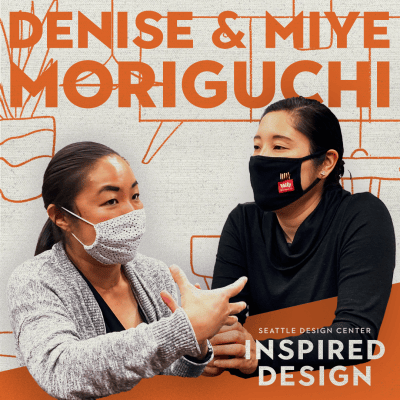
On this episode of Inspired Design join us as we get an inside look at one of the most iconic PNW family-owned establishments, the Flagship Uwajimaya Market. Denise and Miye Moriguchi, the 3rd generation powerhouses leading the business, tour us through the much-loved store while teaching us about its less-known past. Uwajimaya is synonymous with the Moriguchi family’s history, a macrocosmic look at how the market has both changed and stayed the same throughout its existence.
Episode Transcript
Denise Moriguchi:
In 1962, when the Seattle World Fair was in town, my grandfather really wanted to have a presence there. Even though we never got to meet our grandfather, I feel like that was his moment where he decided he wanted to sell to more than just Japanese customers, but really share Japanese food and culture with everyone. I think that’s a moment I think about often and how it’s probably changed the course of who Uwajimaya is today.
Gina Colucci:
I’m Gina Colucci with the Seattle Design Center. Every week on Inspire Design, we sit down with an iconic creator in a space that inspires them.
Mia Moriguchi:
We are at the Seattle flagship Uwajimaya store. This is actually the third physical location in the district.
Gina Colucci:
This week, I met up with Denise and Mia Moriguchi, the powerhouses behind Uwajimaya. Their grandfather started the business out of the back of his truck in 1928. And just last year, Mia and Denise led the company through a $10 million remodel.
Mia Moriguchi:
This latest effort that just completed in October of 2020 was our first major refresh of the store since 2000.
Gina Colucci:
Their story spans generations and decades.
Mia Moriguchi:
This is Denise’s dad and my uncle, right there and another uncle of ours so there were seven siblings.
Gina Colucci:
It is a triumphant one, but not without heartbreak.
Mia Moriguchi:
My father, Denise and the whole family just worked so hard.
Gina Colucci:
Let’s start from the top.
Mia Moriguchi:
We did just enter through the new entry. This is brand new to the store. It used to be part of the produce department and just a rotunda, but we really felt this more grand entry into our produce department was something that would really excite people as they walked in.
Gina Colucci:
Mia studied architecture and design at Yale and worked at a Seattle design firm for 11 years before joining the Uwajimaya leadership team.
Mia Moriguchi:
We really are proud of our produce selection, especially the Asian greens and gingers and mushrooms and all these types of varieties. It changes seasonally so that’s really exciting. And then, if we walk that way, so part of it was really trying to orient customers as they’re walking in. So when you do walk in, not only do you see the produce department, but you can see our meat department and all the way back to our seafood department, which is one of our most proud departments for sure and just the unique kind of character of Uwajimaya itself.
Gina Colucci:
I have to stop here for a second because in that moment, I realized that I had one foot in the present store, a beautiful modern space with thoughtful design elements, but I also had one foot in the past. Uwajimaya has so much history if these walls could talk. I mean they were talking. The backstory of this space and business and this family just pours out of the walls and creates the energy in the air. As we go on our tour, we keep jumping back and forth through time to tell Uwajimaya’s whole story and how these two powerhouse women are at the helm of this company’s next chapter.
Denise Moriguchi:
Uwajimaya was started by our grandparents, Fujimatsu and Sadako Moriguchi.
Gina Colucci:
This is Denise, Uwajimaya’s CEO. She got her MBA from MIT and returned to Seattle to join the family business in 2013.
Denise Moriguchi:
Our grandfather came from Japan then like many immigrants, he was looking for job and better opportunity. So he arrived in Tacoma in the 1920s by boat. There were Japanese bachelors working in mining and fishing and logging camps and he went to where they were and sold them fishcakes. That was his kind of like specialty. So Japanese [foreign language 00:03:40], and then he’d sell them rice and soy sauce. Then as these bachelors started getting married, he opened a store because it now was a different customer shopping. It was the wife. So they opened their first store in Tacoma in the 1920s.
Gina Colucci:
Uwajimaya’s humble beginnings are in sharp contrast to the large team responsible for the multimillion dollar renovation that Mia is telling me about. I used to come here all the time and I had my office right down the street. One thing I do notice is the update of colors.
Mia Moriguchi:
Yes.
Gina Colucci:
How much thought and planning went into picking the right green and the right blue and the right yellow?
Mia Moriguchi:
No, very good point. We worked with a very talented team of designers, and starting with our kind of our new brand expression. So we have some updates on that. Then Hoshide Wanzer Architects were our main architect firm, and then we worked with Cushing Terrell for kind of layout and grocery store layout and design and such, and Bruce Hale for our brand and imagery. It was a very collaborative approach to all of that, but really the overall is we kind of neutralized the palette that used to be here I would say, but wanted to really bring to life some of the certain departments and kind of distinct areas, but in a more intentional way. So we do have a pretty bright green in the produce. We have these large banners. This is an artist from Japan that we found and he had these amazing, beautiful illustrations, so much texture, but also really just it felt right when we saw his work and so we commissioned some of these pieces for this store.
Gina Colucci:
So when I look at these four beautiful banners up above the produce section, you nailed it. They have this great texture to it with these designs. They’re beautiful, but I wouldn’t know that’s an actual Japanese artist. That’s really cool.
Mia Moriguchi:
So you continue through the meat department and you really see all of this beautiful meat, all the cuts. There’s Jesse. So we have much of a more defined meat department, but we do offer a lot of specialty cut meats, so the thin slice meats, pork and beef, and then of course our really high-end Wagyu style beef over there.
Gina Colucci:
And that’s something that you can’t get in a normal grocery store?
Mia Moriguchi:
Nothing up to that amount of it, for sure, or variety I would say. Yeah. [inaudible 00:06:23] … some seasoned pork, so already made for dumplings if you wanted to make the dumplings. It kind of skips a step, which is really nice for [inaudible 00:06:33] … very busy. So our sashimi department, we have restaurant grade quality sashimi fish here, and we really wanted to distinguish it from your experience buying it there at this counter versus buying it at the more fish market type of environment. So we enhanced this, we call it our sashimi island, and it features a house-made poke every day. You can see the sashimi cutters at the corner here cutting expertly, these pieces of fish, and then you can pick them up to go home on all the way around it.
Gina Colucci:
As we’re walking by, people know you. Your workers know you. They’re waving. They feel comfortable. They’re excited to see you. How does that make you feel?
Denise Moriguchi:
Oh, it’s fun because we’ve kind of grown up in the store. So actually some employees they’re like, “I remember when you were this tall,” and it’s to their knee, but it’s just been fun seeing people just be here for so long. We’ve got people who’ve been here 10, 20, 30, 40 years. So we just got to know them and they’re like our family. So it’s nice.
Mia Moriguchi:
They also run into about five family members a day if you were here. We’re moving into more of our deli offerings. I would say our [foreign language 00:07:51], our grandmother would probably be just astounded at what the kitchen and the deli looks like today. We remember her in the old store. She would make lunch for all of the employees every day, and she would hand roll the sushi rolls and the curries and all of the different dishes. That’s what I remember her. She would be in that back corner of the store making lunch. So now, it’s really this place to find all types of different foods ready to eat. We have our sushi, our… Let’s see. We have noodle bowls over here. We have all the kind of, a lot of the traditional side dishes that you find in Japan and different… We have shumai and Vietnamese spring rolls. Yeah.
Gina Colucci:
And back to your grandmother. What do you think she would say?
Denise Moriguchi:
[crosstalk 00:08:49] I think she’d be so proud and just amazed at the volume of products, but also how diverse our customers, employees have become, and that the business has grown since my grandfather and grandmother first started it.
Gina Colucci:
After starting the company, me and Denise’s grandparents had a relatively quiet season of life, about 20 years spent growing their business in the original Tacoma location.
Denise Moriguchi:
With the outbreak of the war, my family was sent to Tule Lake internment camp in California. So they had to leave their business in Tacoma and went to California.
Gina Colucci:
Tule Lake was one of 10 concentration camps built to imprison Japanese-Americans forcibly removed from the west coast during the World War II. It was also the biggest. By the time it closed on March 20, 1946, more than 18000 Japanese Americans had been incarcerated there during the war.
Denise Moriguchi:
And then after the war in the forties, they had to start all over again. So my grandfather heard more people are moving to Seattle versus going back to Tacoma. So he went to Seattle and he opened his first store we mentioned on 422 South Main Street, so just not too far from where we are today. They rebuilt their grocery business, started with a little kind of hole in the wall store. When the next door business moved out, they kind of lease that space, knocked down a wall and expanded their business.
Gina Colucci:
And they kept expanding their business one project at a time.
Denise Moriguchi:
Our first store was in Seattle. We opened a store in south center in the, I think it was seventies or early eighties. We opened a store in Bellevue also in the seventies. We opened a store in Beaverton, Oregon in 1998. We opened a Renton store in 2009. We moved our Bellevue location 2011 or ’12, so where it is right now. Yeah, we remodeled the store recently. So I don’t know what else. Let’s see. [crosstalk 00:11:05].
Gina Colucci:
I was captivated by the whole… There’s just so much history. It’s a quintessential Seattle base, but what really caught my attention was back in the 1920s with your grandfather being a very smart businessman, realizing, “I’m selling these cakes, but now my base is growing,” and I can kind of see that that’s genetically stuck with you, now both of you very savvy business people.
Denise Moriguchi:
Yeah. Definitely, I think we’re proud that our grandparents had insight to really want to appeal to a diverse customer base. But I think another thing we’re really proud of is that our grandparents always made sure the community and the customer were really… They were the most important thing that they wanted to focus on.
Gina Colucci:
I asked me and Denise how they think about their customers today.
Mia Moriguchi:
We talk a lot about our two kind of groups of customer base. We call them the loyalists. The ones that I’ve known as grown up with us, kind of know the cuisine and we know exactly what they want to be buying, and maybe they’re very loyal to certain products like you said. Then we have the explorers who really are discovering new things all the time. Frankly, you can have somebody that does both. They may know very much about Japanese food, but are learning about Vietnamese foods or something like that. But for the explorers, we really want to make sure that they’re getting information and understanding and learning about new products and seeing new things. Then for the loyalists, we want to make sure they have their staple product for a good price, good selection, make sure it’s in stock, but also maybe introduce them to some new things.
Mia Moriguchi:
We talked a lot about customer flow. We recognize we’re in a very urban environment being in the heart of the Chinatown international district, but we are a grocery store. So to the south, we have the parking lot, and a lot of people park and get their shopping cart and go shopping. To the north it’s South Weller, which is a very more intimate pedestrian street. That’s where all of our food hall vendors, they have small store fronts that open up to that neighborhood. So a lot of the customers coming from that way, maybe they work in the neighborhood, they live in the neighborhood and they’re on foot, and maybe they pick up a smaller shopping basket and getting their food for lunch or snacks for tonight or something like that. So they may have very different needs.
Mia Moriguchi:
That’s a lot of the impetus of why we put the entry there and then had that really straight shot. We call it the spine of our store, which is really connecting produce, meat and seafood together in that kind of one environment. Then connecting from the Weller side a little bit more is from the food hall, all the shops, the small shops there kind of snaking around to the sake and beer to that street and continuous of that. So definitely setting off kind of those two experiences within the same store was a lot we talked about.
Gina Colucci:
If you could have a shopper feel like one emotion or one thing when they walk in here, what would that be?
Mia Moriguchi:
Be transported. Too shocking. I don’t know.
Denise Moriguchi:
We talked internally a lot about East discovery and delight. So in discovery, especially for the explorer and making it easy for the loyalist and we want the whole experience to be delightful for all customers. So we really do, we like that discovery feel. We hear stories about our grandparents. So when new would come to town and they didn’t have a place to eat or sleep and they’d be like, “Oh, go see the Moriguchis at Uwajimaya,” and my grandparents would give them a job and let them sleep on the couch and feed them. So I think taking care of customers and being part of the community is something that was really important to them that’s been passed down. So even though we didn’t meet our grandfather, we just know the values that were really important to him that we feel have made Uwajimaya continue to grow and be part of this community.
Mia Moriguchi:
Being in the Chinatown international district is especially important in the city of Seattle, but also our family. Really it was place of our business for so long. We spend so much time down here looking at design and development and how the neighbor has been changing. It is really being part of that conversation has been really important to me especially, just have such a big stake family wise, community wise, and the city is changing so much that I think it’s really important to be in the middle of those conversations. It’s such a diverse community and clearly with lots of different ideas and thoughts and direction and such, but that’s what makes it so interesting and so vibrant. Going through this project and other projects in this district, you realize there’s no other district like this in Seattle. I would say even across the country.
Gina Colucci:
I know that you’ve gone through the larger part of the renovation. Are there still things that you’re going to add?
Mia Moriguchi:
For sure. Yes. We’re working right now on a more, we call it kind of the secondary signage elements, really trying to connect people with food. So there’s a lot of overwhelming products here. A lot of the questions are, “What do I do with this? How do I cook it? Do I eat this raw? Do I cook it? How long?” So trying to connect people with those foods, and we think we can do that in a variety of ways. One being signage components. There’s some way finding signage, but also here’s so-and-so’s favorite sake, or this kind of tastes like chicken. You should try it, or that kind of thing. So we’re working on that. Some of the signage could be showcasing our local vendors. A lot of our bakery items come from Seattle based, born and raised kind of bakery items. We have the Cakes of Paradise, the hood famous bake shop in here. I don’t know. Do you want to go check out that way? [crosstalk 00:17:11]
Mia Moriguchi:
So we’re in our, what we deemed as our retail street. Here, this is all the products that are much more exciting in a way. We have snacks to our left here with just the tons of varieties of different Asian snacks, rice cake, rice crackers, mochi, all those different flavors, Pocky. This is a more fun environment. I think you talked to lots of kids who grew up in Uwajimaya and this is what I remember. You go to the snack department and you pick out all your [foreign language 00:17:42] and your rice crackers. [crosstalk 00:17:44] Yeah, exactly. So we really want this to be a kind of a very different feeling than when you’re buying snacks and say, you’re buying your fish. So we call this kind of our retail street. So it starts with the Saki and beer and beverages, all of the Japanese teas and different specialty beverages there. It moves into our snack selection, which is piled high with products and a little bit on the messy side where it’s just a different feel.
Gina Colucci:
I definitely get that. Kind of you’re feeling almost like you’re at a street market with the lights and the variety and the colors. Do you have one item that’s still here that you just remember as a child?
Mia Moriguchi:
Oh, yeah.
Denise Moriguchi:
Well the [foreign language 00:18:28], that one right there. This is from… I don’t know how long they’ve been making this. It used to have a toy in it. Now, it has a sticker, but I remember getting this all the time when I was a kid and now I buy it for my kids all the time. I think it’s been around since, oh gosh… I should look it up. I feel like at least over 50 years, if not a hundred years. I don’t know.
Gina Colucci:
Is there anything else that really just like transports you back to your childhood?
Denise Moriguchi:
Oh, that one. This drink over here, it’s like a very popular drink in Japan at fairs and festivals. There’s a marble on the top that’s holding it kind of together and you pop the marble down and it releases the carbonation. So this is a really fun drink we’d have when we were a little.
Gina Colucci:
So when you bring your kids here, they’re kind of experiencing kind of what you did just in a different generation. So what is that like?
Denise Moriguchi:
They’re always so excited to come pick out snacks. My dad used to make me pick up garbage and stuff when I was here, and I make them and I make them do that. So it’s just fun to see them kind of understand this is part of their family and who they are, so they can take pride in it and also help keep it clean. I don’t know. But they just love coming here with me and finding new fun products. They always want candy or some kind of cookie snack. [crosstalk 00:19:53].
Mia Moriguchi:
That’s why I don’t bring my kids here.
Gina Colucci:
A quick lesson in the Moriguchi family tree. Denise and Mia’s kids are the fourth generation. Besides stocking up on candy and picking up trash, they’re too young to be a part of the family business. Although, both Denise and Mia told me that they hope the fourth generation wants to get involved. They feel a sense of duty to keep growing and innovating the business. So the fourth generation is excited to step in and doesn’t feel burdened. Back to the family tree. Denise and Mia are the third generation. There are nine cousins and spouses involved in the company in some way. Denise becoming CEO was the official transfer of power from the second generation, their parents, aunts, and uncles to the third generation.
Gina Colucci:
You have some very powerful women in this family.
Denise Moriguchi:
Yeah. I chuckle often our grandfather was more traditional in the sense that when he did leave the company, he left it to his four sons, even though there were three daughters and four boys. He gave each son 25%, which that was actually kind of progressive for his age because usually it just went to the eldest son, but it did end up with the girls. So I kind of left some days thinking about now how his youngest daughter ended up running the company for several years, and we have a number of strong women at the company from our family.
Denise Moriguchi:
We should note, so our generation there’s 19 of us and then 15 of us are female. The numbers just kind of fell in our favor. So it’s not really that surprising that we have so many women cousins working in the business, but I don’t know. I feel the family is very supportive of it, and especially our aunt Tomoko who’s the youngest sibling who ran Uwajimaya for many years. She’s just very outspoken and won’t take crap from anyone. So I think she really paved the way for us. It’s not so surprising now because she’s already like put them in their place and told them, “Shut up.” Females are here to run the company. So she blazed the trail for us.
Gina Colucci:
Also, you said that was your aunt, but your grandmother who said she was pretty elderly and still getting on the bus coming here to work. That’s dedication. That’s a powerful woman. [crosstalk 00:22:23] Yeah.
Denise Moriguchi:
Yeah. She was really the backbone of Uwajimaya, just kept the place running. When the siblings were running it, there’d be little squabbles, but she would make sure that you remember it’s family and everyone still loves each other. So she was definitely a very impactful force and driving force to the growth of Uwajimaya.
Gina Colucci:
Yeah. Speaking of her, and this is something… She had four children in a Japanese internment camp. [crosstalk 00:22:55] Your grandmother- [crosstalk 00:22:57] Oh, she gave birth to- [crosstalk 00:22:59]
Mia Moriguchi:
Two children.
Gina Colucci:
Can we go a little bit into- [crosstalk 00:23:02].
Mia Moriguchi:
Sure. Yes. My grandmother gave birth to two children in Tule Lake in the internment camps. One, which was my father in 1944. So, yes. Talk about a very strong woman. But she did have four children when they went to Tule Lake- [crosstalk 00:23:24] … and then she had two more.
Denise Moriguchi:
Well, there’s seven total. [crosstalk 00:23:28].
Mia Moriguchi:
No, because [inaudible 00:23:30] Japan.
Denise Moriguchi:
Yeah.
Mia Moriguchi:
Yeah, so they had another daughter who was in Japan at the time and then came back and joined. So there’s seven total siblings, all of who grew up in Seattle, went to Garfield High. So we’re very rooted in Seattle.
Gina Colucci:
Wow. Japanese internment camps is not something I learned about until I was older and it’s not something that’s talked about that much, which is very unfortunate because we need to learn from that. How do you feel about it and how do you kind of… Have you told your children about it yet?
Denise Moriguchi:
So my father went into the camp, I think when he was around six and that’s the age my son is now. So I look at my son and think, “Gosh, how would he manage it?” But we have talked about it. There’s been a lot more awareness. I feel like in the past several years, but it’s something my grandmother never wanted to talk about. It was kind of a period she just wanted to put behind her. So I learned about it in school as well, really.
Mia Moriguchi:
Tule Lake’s really interesting. It’s the No-no group. From what I remember, you had two questions you were asked. Do you pledge allegiance to the U.S.? And if you had the chance, would you go back to Japan? And if you answered no to both of those… Would you stay in the U.S. or something like that. So it was like if you said no to both of those, they sent you here. So really, I think if the war extended, many of those families would have been probably sent back to Japan. So they were treated in a different way too.
Gina Colucci:
The No-no group that Mia mentions, that’s based on inmates’ answers to an infamous, “loyalty,” questionnaire. The survey was flawed from the start. The questions were ambiguous, and just about any answer got you labeled as disloyal. Because of this, Tule Lake became a segregation center and was then under maximum security. It was ruled under martial law and occupied by the U.S. Army.
Mia Moriguchi:
I remember going to California with my family trip to Tule Lake, nothing to see, a barbed wire fence and dust. And I’m sure that’s exactly how it was back then, too. So we did talk about it. I know it wasn’t a intensive conversations by any means, but I think it was something that always he clearly doesn’t remember much as being just a baby, but IT for sure shaped the family and everyone for sure.
Gina Colucci:
I asked how their relatives’ time at Tule Lake shaped their family. Denise and Mia told me that the whole family just worked so hard. It was always about work and family. They saw the impact this had on their parents, aunts and uncles, even though they were largely sheltered from the peaks and valleys of running a family business. Denise and Mia both took on their roles at the head of the company knowing how hard a family business can be. They both agreed the lows are low, but the highs are high.
Denise Moriguchi:
One of our family traditions used to be making mochi. Mochi is like a rice cake, but you have to eat it on New Year’s in Japanese in culture. Now, we can buy it and it’s easily available from other places. But before that, we used to get together the week before… I guess in between Christmas and New Year’s and we come after the deli was closed and we’d all have different roles. Our uncles would be pounding the mochi, so the rice would get into a kind of… I don’t know. What do you call it?
Gina Colucci:
Paste?
Denise Moriguchi:
Paste, yeah. Then some people would cut it. Some people would flip it. I was a young kid, so I just kind of flipped the mochi to help it cool. Then we got older, we would wrap it, put it on the trays and wrap it. So we did that for several years. So we’d do that, we’d eat dinner, we’d stay. I don’t know. It felt really late. It would probably was only like 10 or 11, but we were young. [crosstalk 00:27:30].
Denise Moriguchi:
Then we’d get together for Christmas Eve dinner. We’d get together for Christmas morning brunch. We’d get together for Christmas dinner. Now, since our family’s grown so much, we don’t do it to that extreme. But I just remember those times fondly of everyone being together, making the mochi and working in the store. I remember Mia’s dad out in the parking lot directing cars with his high vis vest and my dad would be pushing carts. The holiday is definitely our busiest time and we all just kind of come and help. My brother works in the fish department in the holidays and it’s a fun time.
Gina Colucci:
Hey, what’s your favorite item you can only get at Uwajimaya? Head to Seattle Design Center’s Instagram post for this episode and tell us about it. Inspire Design is brought to you by the Seattle Design Center. The show is produced by Larj Media. You can find them at larjmedia.com. Special thanks to Michi Suzuki, Lisa Willis and Kimmie Design for bringing this podcast to life. For more, head to seattledesigncenter.com where you can subscribe to our newsletter and follow us on social media. If you’re looking for inspiration, come check out the Seattle Design Center in Georgetown. We’re open Monday through Friday nine to five. On the next episode of Inspire Design, we get a look at Tom Douglas’s favorite place to cook, his home kitchen.
Speaker 4:
Well, the first day we walked in, the mountains, it was crystal clear out there. [crosstalk 00:29:03] The mountains were snow capped. It was November. It always reminds me of that day we walked in here and then- [crosstalk 00:29:10]. We couldn’t afford the house and we did it anyway.
Nathan Myhrvold’s Cosmic Curiosities
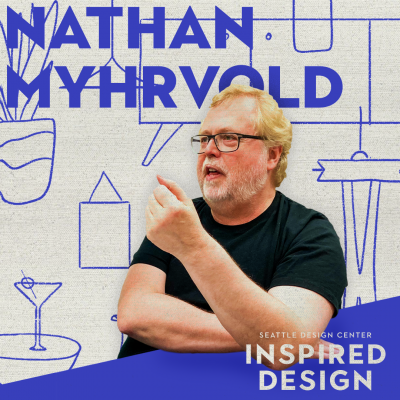
In this episode of Inspired Design, Dr. Nathan Myhrvold, a prominent scientist, technologist, inventor, author, and food photographer takes us on a tour through his Modernist Cuisine studios in Bellevue, WA. Get a glimpse into his wild world of creation and hear his hope for Seattle as we contemplate how imperfect design is a common thread through past civilizations.
Episode Transcript
Gina Colucci:
I’m Gina Colucci with the Seattle Design Center. Every week on Inspired Design, we sit down with an iconic creator in a space that inspires them. This week, I caught up with Nathan Myhrvold at his Modernist Cuisine studios in Bellevue Washington.
Nathan Myhrvold:
Here we pump water up, about 55,000 pounds per square inch. And that water can then be used to cut insanely hard metal or glass.
Gina Colucci:
Nathan is part entrepreneur, part inventor, photographer, chef, scientist, designer. But really, he is a highly educated generalist who spends his time tinkering in various disciplines, too many to count.
Nathan Myhrvold:
I am the world’s foremost expert on dinosaur vomit.
Gina Colucci:
He’s the only person I know with a PhD and a culinary degree.
Nathan Myhrvold:
Pizza is a poorly documented cuisine.
Gina Colucci:
Not to mention he spent over a decade working at Microsoft and did a post-doctoral fellowship at Cambridge under Stephen Hawking.
Nathan Myhrvold:
This is a mock-up of a nuclear reactor core.
Gina Colucci:
My conversation with Nathan was all over the map, literally. He travels to all sorts of places to optimize the best photos.
Nathan Myhrvold:
A billion cicadas will come emerging out of the ground on the East Coast once every 17 years.
Gina Colucci:
The tour of his space was like flipping through my fifth grade science book and stopping on all these different random pages.
Nathan Myhrvold:
Charles Babbage was a British genius who, in the 1840s, decided to make computers.
Gina Colucci:
I think the special thing about Nathan is that he has an ability to shift your perspective because he’s going to show you something ordinary in a way that you’ve never seen before.
Nathan Myhrvold:
So here, if-
Gina Colucci:
Can you describe what we’re looking at?
Nathan Myhrvold:
This is some pictures of blueberries, but the blueberries are bigger than a basketball here, in an actual size, in the photo. Now, if I had just taken one picture of this, the amount that’s in focus, this would have been incredibly shallow, incredibly shallow. This is about 500 photos. And so, we take 500 photos and then we use software to put them together. Well, it’s funny. They’re so big. And out of context, a lot of people don’t realize they’re blueberries. They’ll say, “What is that?” Or, this?
Gina Colucci:
Yeah. Okay. That’s the inside of a blueberry.
Nathan Myhrvold:
Yes. Did you know that blueberries had orange seeds?
Gina Colucci:
No.
Nathan Myhrvold:
I didn’t either. Or that the flesh is green.
Gina Colucci:
Yeah.
Nathan Myhrvold:
But, it is.
Gina Colucci:
I know what the inside of the blueberry looks like because my toddler smashes everywhere. So I know that. I didn’t know the seeds were orange and has, like, little cells. Like, I don’t even know what to-
Nathan Myhrvold:
Those are cells.
Gina Colucci:
Okay.
Nathan Myhrvold:
That’s individuals. You can see here and here and here, individual cells. So that’s how close up we’re getting. You can see the individual cells that make up the thing. And the thing I like about these photos is that they take a very familiar object and they show it to you in a very unfamiliar way. You can live your whole life eating blueberries without ever really looking at a blueberry because that’s not required. And if you do look at it, you’re going to look at it with human scale eyes, not with this kind of magnification. So when you do look at it, you get to rediscover it in a new way.
Gina Colucci:
As my eyes darted around Nathan’s office, because there’s just so much to look at, a bunch of stacks of papers and his computer and pens and notebooks. And then you turn and there’s just a plethora of different machines and microscopes and camera gear. And then there’s also a whole table of screwdrivers and Allen wrenches and pliers, all different sizes and shapes and colors. I spotted this skull on his desk, basically being used like a paperweight.
Gina Colucci:
I mean I have to ask, and I will, what is this skull of?
Nathan Myhrvold:
That’s a skull of a water Buffalo. Now, the reason for that, I just finished a book on pizza. The traditional cheese to put on pizza is Mozzarella Di Bufala. The Bufala part is actually an Asian water buffalo. It’s weird, but somehow water buffaloes from, like India, got to Italy, probably brought by the Romans. We actually figured a whole lot of stuff out about that for the book. So most people don’t know that this Italian thing is actually from an Asian water buffalo.
Nathan Myhrvold:
And then I had seen a chef make a flower out of mozzarella by carving the mozzarella so it looked like a white rose. So I did this homage to Georgia O’Keeffe, where we had the buffalo skull, and then some flowers made of either mozzarella or tomatoes.
Gina Colucci:
That’s amazing.
Nathan Myhrvold:
Now, strictly speaking, was that necessary for the book? Well, I don’t know.
Gina Colucci:
Yes. Yes. A hundred percent.
Nathan Myhrvold:
It was definitely fun.
Gina Colucci:
Yeah.
Nathan Myhrvold:
And it makes the point that it’s Asian water buffaloes, not cows, or not some Italian creature.
Gina Colucci:
Yeah, not an indigenous-
Nathan Myhrvold:
Nope.
Gina Colucci:
That’s amazing.
Gina Colucci:
I’m not the tiniest person. I like to say that the most creative people need some chaos. Are you in agreement with that?
Nathan Myhrvold:
Yes. I mean, I actually like it better if it was all neat. I’m just not going to take the time to do it.
Gina Colucci:
You have much better things to do.
Nathan Myhrvold:
Exactly. And as long as it doesn’t get too bad-
Gina Colucci:
No, I would say this-
Nathan Myhrvold:
Things are okay.
Gina Colucci:
Yeah.
Gina Colucci:
This way?
Nathan Myhrvold:
This way.
Nathan Myhrvold:
This is one with the crazy camera things that I built for a very specific shot, which you’ll see. So we call this The Three Amigos, and normally if you’re shooting pictures of wildlife or other things at a distance, you’ll use a very long lens. And this is the longest lens photographers typically. This is a 600 millimeter lens. During the pandemic, I was watching one of those BBC Earth things.
Gina Colucci:
With all… Yeah, with the rest of the country.
Nathan Myhrvold:
And they have these spectacular ocean waves. I want to go photograph big ocean waves during a storm. But to do that, you both need to have a long lens, but you also want a panorama. And then I also saw a bunch of bird migration things. That would be a spectacular thing to use this for.
Nathan Myhrvold:
So here we have The Three Amigos at work.
Gina Colucci:
Wow.
Gina Colucci:
So The Three Amigos camera, how do I… I mean, how do I even describe this? Picture a giant camera, multiply it by three, and then put on three giant lenses, the biggest lenses you’ve ever seen. Nathan has built this custom stand for them. And so it puts them all in a row. And the lenses of them probably extend over a foot long.
Nathan Myhrvold:
This is from a place in Missouri where enormous numbers of snow geese come during migration.
Gina Colucci:
The photo itself, printed out, is probably about five feet long?
Nathan Myhrvold:
Yeah.
Gina Colucci:
And it’s a beautiful sun rise, so you get the orange going up into yellow and then green, and you have a horizon. And then there are hundreds of thousands-
Nathan Myhrvold:
Probably. Many, many thousands.
Gina Colucci:
Many, many thousands of geese just flying throughout the entire panoramic image.
Gina Colucci:
Do you know how many snow geese are in this photo?
Nathan Myhrvold:
I have not literally counted this photo. I mean, in the refuge where we were, they were estimating 700 thousand. Now the thing that snow geese is they roost down in the water, the very shallow water at the edge. And then as soon as the sun comes up, they all take off at once. And that’s what this is about.
Gina Colucci:
How loud was that?
Nathan Myhrvold:
It was loud.
Gina Colucci:
Yeah.
Gina Colucci:
Nathan’s passion for food and photography started at a young age. By age nine, he was cooking Thanksgiving dinner for his family, and soon had a camera by his side to capture everything.
Nathan Myhrvold:
This is one that we’re getting ready to take. So this is the 4/40 tornado. We name all of the things. These are 40 millimeter lenses. So it’s four 40 millimeter lenses and cameras.
Gina Colucci:
The top case for this camera, it was kind of like an erector set on steroids. Super sleek, very industrial feel to it.
Nathan Myhrvold:
Yeah. In the previous incarnations of this, it wasn’t as compact. And it took like half an hour to set up. Anyway, on a Friday, I’m going storm chasing to photograph tornadoes. That’s why this is called the 4/40 tornado. And for a tornado, what you have to do is stop at the side of the road, jump out, take pictures. And while people are yelling, “We have to go.” And then you jump back in. So this whole thing was designed so we can do that.
Gina Colucci:
So it’s just two, really. Two pieces with the cameras.
Nathan Myhrvold:
Two pieces. That’s right.
Gina Colucci:
Wow.
Nathan Myhrvold:
Normally what storm chasing is, is hours and hours and hours of riding in a car, looking for storms. And then, moments of sheer terror.
Gina Colucci:
And what’s the hopes that you will get the largest panoramic photo of a storm ever taken?
Nathan Myhrvold:
Well, if this thing works at all, that will be true.
Gina Colucci:
Okay.
Nathan Myhrvold:
We’ll see. You don’t know whether you’re going to see a tornado or not, but even a normal thunderstorm in the Midwest is pretty damn spectacular. We never really get thunderstorms here. There, it’s really something
Gina Colucci:
So do we want to… There’s so many more things in this room.
Nathan Myhrvold:
Well, let’s keep going just to…
Nathan Myhrvold:
Okay. So now we’re going to go down into our machine shop. You get to have a peek here above it.
Gina Colucci:
So we’re looking down now and at your machine shop and it almost looks like there’s a giant yellow-
Nathan Myhrvold:
That’s a crane.
Gina Colucci:
Yep, folks. A crane. Like a three-story crane inside the machine shop.
Nathan Myhrvold:
The point of those overhead cranes is that we can move heavy things around the shop.
Nathan Myhrvold:
So here we have all manner of machine tools, which torture metal or plastic or wood in different ways. This is one I bought just this last year.
Gina Colucci:
The machine tool for the furniture had its own little home. Like, it had doors on that you would slide open. And then inside was the actual machine that printed.
Nathan Myhrvold:
I actually bought it to make furniture.
Gina Colucci:
What do you think will be your first piece of furniture?
Nathan Myhrvold:
A chair. I’ve been working on a chair. But, a cool chair.
Gina Colucci:
For a cool chair.
Nathan Myhrvold:
Yeah.
Gina Colucci:
There were so many machines, I didn’t even know where to look.
Nathan Myhrvold:
This is my Babbage engine. So Charles Babbage was a British genius, who in the 1840s, decided to make computers. But of course they didn’t have electronics in the 1840s, so he made his computer out of gears.
Gina Colucci:
Average machine has 8,000 parts, weighs five tons, and measures 11 feet long. There were all these rungs with numbers going down. It was kind of like an abacus meets a printing press, meets a machine from the 1800s.
Nathan Myhrvold:
He never finished it during his life. And people thought, oh, it was ahead of its time, and his plan will never work. Well in the nineties, the science museum in London realized they had the plans. So they decided to build one and find out could Babbage have succeeded? Well, just like Babbage’s project, they ran out of money. But then they met me. And I said, “Could you do two?”
Gina Colucci:
Why do one when you can have two?
Gina Colucci:
A little extra history on Charles Babbage. His wealthy father supported him financially so he could tinker and event all he wanted. He studied at Cambridge and then became part of London’s intellectual society, and kept company with well-known people, including Charles Darwin and Charles Dickens. While he never completed the full machine, he built a fragment of it and would show it off at as well attended society parties.
Nathan Myhrvold:
The great thing is, his plans work perfectly.
Gina Colucci:
That’s amazing.
Nathan Myhrvold:
Yeah.
Gina Colucci:
Wow.
Nathan Myhrvold:
And it’s a very complicated machine to have thought through upfront. On most machines, you think things through as much as you can upfront, and then you make a first version like, oops, I didn’t leave any place for this. But, not Babbage.
Gina Colucci:
The thing I saw next blew my mind. I wish I could describe what this looks like to you, but I’ve never seen anything like it before. It was bright blue metal and it almost looked like a giant drill the size of a VW bus.
Gina Colucci:
Now we’re underneath the giant yellow cranes.
Nathan Myhrvold:
Yeah. So this is a mock up of a nuclear reactor core that TerraPower, one of the companies I helped start, created. So that is a reactor core, or it could be.
Gina Colucci:
Could be. Wow. And you’ve got your photography going. You’re building a chair. Do you consider yourself a designer?
Nathan Myhrvold:
This is one of these things where, if other people don’t consider it, you that, should you be calling yourself that? It’s a fascinating question. Some people, if they ask me, am I an artist, it’s the same thing. Well hopefully, the things that I, the photographs that I make, or the things we do in the books, or other stuff, do have strong elements of design and aesthetics and art in them.
Gina Colucci:
How do you translate the importance and beauty of technical design?
Nathan Myhrvold:
Well, you know, the technical objects, cameras or things of that sort, have functionality on top of whatever aesthetic requirements you have of them. Now, sometimes just following the technical requirements actually produces something that’s pretty beautiful and pretty interesting in its own right. But it requires lots of creativity and different kinds of creativity, perhaps, to try to make sure that you get the functional things that have to be there done while, at the same time, achieving some other goal.
Gina Colucci:
You’ve been quoted as saying that, “Technology isn’t a barrier to emotion or creativity. It’s a great enabler.”
Nathan Myhrvold:
Well, I think… Throughout history, there are many artists who have been at the cutting edge of technology development. Leonardo DaVinci being a great example. You could argue he was an engineer. You could argue he was a chemist. You could argue he was lots of things. He was also a great artist. And photography is the recent example of that, right? So photography was a brand new thing in the middle of the 19th century and it allowed us to create a new art form, or a new means to art. And I think great photographs can be art as profound as any sculpture or painting. But if it wasn’t for the technical invention of it, you wouldn’t have it at all.
Nathan Myhrvold:
Well, more recently, we’ve had the technical development enable new things, like enable pictures of the stars. Or in the case of these camera outfits that I build, enable a slightly new kind of photo. And I think that that is an enabler of creativity.
Gina Colucci:
You’ve basically wrote the book on following your passions and designing your life. How did you do that? Do you have like a moment that you were like, “I’m going to fully embrace who I am”?
Nathan Myhrvold:
Well, so one of the problems with being me is that, in general, the world rewards specialization. The further you advanced your education, generally, the easier it is for you to carve out a unique place for you in the world, the more you get paid, the more you get rewarded. Lots of companies are run by people who’ve worked for the company for 25 years, and a combination of talent and surviving attrition and experiences brought them up to this key place. And none of that’s very attractive to me because I’ve always been interested in so many things.
Nathan Myhrvold:
I have friends in each of my different pursuits that can’t quite figure out why I waste so much time on the other ones. My physicist friend, I have a PhD in physics, and my physicist friends all will wonder and chortle just out of hearing, or sometimes just in it, in hearing, what a shame it is that I never had a career in physics. I’m like the guy gone bad to them. And the photographers will say, why aren’t you going to be at the other migration next month? And why aren’t you going to be at this. And why aren’t you going to be at that? Well, the answer is because I’m going to shoot storms, or whatever the answer turns out to be. I’m making pizza. But I like doing all of it.
Gina Colucci:
Yeah.
Nathan Myhrvold:
And I’m not sure I really have a choice in that. I just…
Gina Colucci:
I think what’s nice about this part of the conversation. It kind of humanizes this larger than life figure. I had a million other questions for Nathan and not enough time to ask them all, but I couldn’t leave without asking about dinosaurs.
Gina Colucci:
So you have a replica of a T-Rex in your living room.
Nathan Myhrvold:
I do.
Gina Colucci:
And then you found a T-Rex after that.
Nathan Myhrvold:
Yes.
Gina Colucci:
Can you tell us a little bit-
Nathan Myhrvold:
Yes. It’s like having a picture of somebody else’s kids up in your house. Yep, that’s a T-Rex, but it’s not my T-Rex.
Gina Colucci:
How tall are these ceilings?
Nathan Myhrvold:
Oh, they’re real tall.
Gina Colucci:
Yeah.
Nathan Myhrvold:
Well, the dinosaur in the mount is maybe 18 feet tall, at its tallest point. So the ceiling is taller than that.
Nathan Myhrvold:
So everyone who studies dinosaurs seriously loved dinosaurs as a kid. Now that’s not true for most professions. Most people have a job that they didn’t realize existed when they were a child. But not people in dinosaurs. So everyone who studies dinosaurs loved dinosaurs as a kid, a hundred percent of us. And basically I was working at Microsoft and I had some dealings for Microsoft with Steven Spielberg, and he invited me to the set of Jurassic Park. That sounds cool.
Gina Colucci:
Yeah.
Nathan Myhrvold:
So I went down to visit and they had a paleontologist there as the consultant for the thing, named Jack Horner. Well, Jack and I immediately hit it off. And soon after that, I started doing serious research on dinosaurs. And so, I’ve published many papers on dinosaurs. I’m working on at least two different dinosaur papers right now with various colleagues from around the world. And so, I am the world’s foremost expert on dinosaur vomit.
Gina Colucci:
That’s something not everybody can say.
Nathan Myhrvold:
The trick is getting all the way to the end of the sentence without laughing. That is the trick. It’s tough.
Gina Colucci:
You nailed it.
Nathan Myhrvold:
But it’s true. I wrote a whole scientific paper on dinosaur vomit. It turns out… Well, now here’s the better thing. There’s almost no examples, and that’s the mystery. So owls will eat rodents and birds, and afterwards they cough up something called an owl pellet. Well, it turns out, across the animal kingdom, huge numbers of birds do this, not just owls. Owls are the most famous example. But most insect eating birds do the same thing with the insect, parts of the insect. Like the outside of a beetle, the exoskeleton is too difficult for them to digest.
Nathan Myhrvold:
So anyway, the dinosaurs almost certainly did this. But it’s been very difficult to find an example of that. And that’s sort of what my paper is about.
Gina Colucci:
So you found an example.
Nathan Myhrvold:
There’s a few… I haven’t personally found one, but I’ve identified some that the other people have found. I also have done big size of dinosaur growth rates and dinosaur biomechanics. I showed that there was a set of large dinosaurs called sauropods, which had huge long whip like tails. They also had huge long necks and little itty-bitty heads. So Brontosaurus, now called apatosaurus, is an example. Well, people never figured out what the tails were for. And I proved that the tails were actually used like a bullwhip. Now, a bullwhip makes a huge noise and it does so for a very counter-intuitive reason. It actually breaks the sound barrier. So the noise you’ll hear from a bullwhip going crack is actually a sonic boom. Well, I figured out that in fact, these dinosaur tails were perfectly proportioned to make sonic booms.
Gina Colucci:
So, is that how they communicated?
Nathan Myhrvold:
It’s very likely how they communicated. In particular, there’s a place on a bullwhip which is what wears out first if you’re using your bull bullwhip all the time. And it’s in a weird spot. It’s about a third of the way down the bull whip, and it’s because that area gets a lot of stress. Well, about half of the specimens of these dinosaurs have a bone abnormality at that spot. And it’s a bone abnormality very similar to what humans get when we overuse muscles or joints. So half of the specimens were cracking their tails, almost till their tails fell off, which seems like male behavior to me.
Gina Colucci:
[inaudible 00:25:58]
Nathan Myhrvold:
Well, most weird things in biology is you’re not to be sexual selection. Antlers, for example, on deer. I think that they cracked their tails to get a date and the noise, which would travel for… If you’re an enormous animal, you eat a lot. So you can’t be really close to your own kind all the time because you run out of food. So you have to communicate for a long distance. People have found that elephants can communicate across 40 miles, for example, for this reason. So I think this is how they got a date.
Gina Colucci:
Dinosaur bones, nuclear reactor, cores, pizza ovens, tornadoes, geese migration, Nathan finds inspiration in all of these things. How? What is his through line?
Nathan Myhrvold:
One thing I love about the natural world are the cool aspects of that, that you can see that in the skeletons of the dinosaurs or, I’ve got some other creatures, too. You could also see it in some of the crazy manmade items that we’ve made. I have a big collection of radio tubes which, before transistors and solid state stuff, that was the big thing. And I’ve got a collection of old computers, which was how we’d do that I’ve got a couple engine blocks in my living room.
Gina Colucci:
And the first computer downstairs.
Nathan Myhrvold:
Well, I have, yes, that downstairs. And those are all inspiring in different ways. The human created things, particularly those that are created for a very specific mission often can be beautiful and can be very interesting objects in their own right. Meanwhile, the natural world is full all of these other incredibly beautiful and incredibly awesome things. And sort of the third aspects of that are moments, which you can’t capture except via photography. And so, photography is the other.
Nathan Myhrvold:
So I like to say, though, that in my house, I don’t have any deliberately human created art. I have my own pictures, which I’ll consider either not human created or not art. But I have mechanical devices, but those weren’t created to be art, but I think they kind of are. And then I have the natural things. And I think that, well, we live in a very technological society, and one aspect of that technology society is we tend to get rid of things that are old. But sometimes that old technology is kind of beautiful in its own right. Almost even more, if it’s what’s passed you by, and it’s not the original great, wonderful thing.
Nathan Myhrvold:
So the other thing is, people… I’m not one who’s ever going to hide his TV in something where you press a button and it comes out or some other thing. It’s like, no. I’m proud of that there’s a TV there. And there’s an old microwave tube sitting right next to it for how they used to transmit it. And, and, and, and… I think that, well, just as steam punk looks to a certain era, I’m trying to anticipate what the steam punk of 50 years from now will be, because it’s kind of how I live. When all my stuff is antique and weird.
Gina Colucci:
Well, I guess that’s the perfect segue to my last question. You’ve studied a lot of past civilizations. Has that made you kind of contemplate what future civilizations will think of us?
Nathan Myhrvold:
Oh, sure. I mean, I love visiting ruins around the world. And it’s actually something I tell some of my designer friends who are very exacting about making sure every detail is correct. I say, you know, I don’t know. I was in the pyramids, and the detail, a lot of the details are all screwed up. It’s still pretty God damned awesome. You don’t actually need every detail to still be awesome.
Nathan Myhrvold:
But we’re living at probably the fastest rate of change, any point in our history. We still have lots of ways to go. We still have tons of things that we have to accomplish both from a social agenda and from a human agenda, with respect to advances in medicine. So I’m hoping a whole lot of the things that we currently do become obsolete. Another thing I have at home is a Civil War surgeon’s kit, which is this whole… It’s like a tool kit, but of all of these things they would use, and a lot of them are pretty horrific because that was like, “Oh, you got a scratch? Well, best we better take the arm off of the elbow.” I’m exaggerating a little bit, but the state of the art medicine of that era is horrific to us. And I’m sure hoping that medicine today seems horrific at some point.
Nathan Myhrvold:
Yet at the same time, we’ve been in a period of relatively, well, informed continuity, I’ll say. It’s not the same as the Renaissance. But from the Renaissance to us, there was no dark ages where everything was lost. We have all of the writings, or almost all the writing and almost all of the stuff there. You can go to Florence and see all of it, and it’s still awesome, and it’s still made for us, effectively. So although politically, we’ve advanced and technology has advanced since the Renaissance, we’ve enormous continuity. It’s probably a longer period of continuity than most times in human history. And so I’m hoping that what we do is we continue like that. That Seattle circa 2021 seems as quaint as Florence circa 1500 does to us today, but not because we went through some enormous catastrophe, but rather because we managed to keep it together while society in the world evolved.
Gina Colucci:
Nathan’s space is full of quirky items. What’s the most unexpected thing you have in your home? Head to Seattle Design Center’s Instagram post for this episode and tell us what it is.
Gina Colucci:
Inspired Design is brought to you by the Seattle Design Center. The show is produced by Larj Media. You can find them at L-A-R-J, media, dot, com. Special thanks to Miji Suzuki, Lisa Willis, and Kimmy Design for bringing this podcast to life. For more, head to seattledesigncenter.com, where you can subscribe to our newsletter and follow us on social media. If you’re looking for inspiration, come check out the Seattle Design Center in Georgetown. We’re open Monday through Friday, nine to five.
Gina Colucci:
On the next episode of Inspired Design, Denise and Miye Moriguchi give us a tour of the recently remodeled Uwajimaya flagship store in the heart of Seattle’s international district.
Denise Moriguchi:
I would say our [foreign language 00:34:27] and our grandmother would probably be just astounded at what the kitchen and the deli looks like today. We remember her in the old store. She would make lunch for all of the employees every day, and she would hand roll the sushi rolls and curries, and all of the different dishes.
Linda Derschang’s Tavern Tales
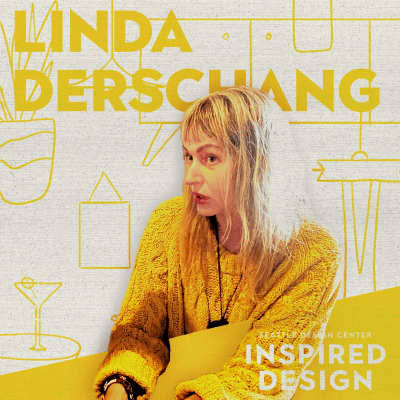
In this episode of Inspired Design, Linda Derschang, founder and CEO of The Derschang Group takes us on a wild trip down Seattle grunge memory lane and coins her iconic style High/Low. Learn how and why she uses storytelling to create her infamous gathering places. And wait, did she just say frosting, as in cake?
Episode Transcript
Linda Derschang:
I said, “Can you please find an avocado green, a pink, purple, some kind of colored sink?” I just think that sink is fantastic.
Gina Colucci:
I’m Gina Colucci with the Seattle Design Center. Every week on Inspired Design, we sit down with an iconic creator in a space that inspires them.
Linda Derschang:
Here we are in Linda’s Tavern.
Gina Colucci:
That’s Linda Derschang, the creative genius behind Linda’s Tavern on Capitol Hill.
Linda Derschang:
And it has looked pretty much the same since ’99, although it opened in 1994.
Gina Colucci:
Linda has opened 15 businesses over the course of her career, nearly all of them in Seattle. Oddfellows, King’s Hardware, Smith, the Bait Shop. The list goes on.
Linda Derschang:
I had a clothing store on Broadway, previous to owning Linda’s and my store was not doing particularly well. It had at one point. By ’92, ’93, there was a lot of competition, the neighborhood changing, et cetera. I was very good friends and still am with Jonathan Poneman from Sub Pop and friends with Bruce Pavitt. Nirvana had just started getting really big in, would that have been ’91, ’92? Anyway, it financially benefited Sub Pop, so going from a small, scrappy, super cool record label to a still small, scrappy, but very well known record label that actually had now some money happened in the early ’90s. Jonathan reached out to me and said, “Bruce and I have been thinking about opening a bar. What do you think? Want to do it with us?” That really was the beginning.
Gina Colucci:
A quick bit of history here. Bruce Pavitt started a fanzine called Subterranean Pop in the early 1980s as part of a class project at Evergreen State College in Olympia. He quickly began alternating issues of the fanzine with compilation tapes of underground rock bands. Jonathan Poneman joined the scrappy label in the late ’80s. It was not long after that, they released Love Buzz, their first Nirvana single. (music)
Linda Derschang:
When I was young, ’80s, ’90s, people weren’t called creatives. You were an artist or you weren’t. If I were a young person now I would say I’m a creative and how do I make a career out of that? But then, I really didn’t know. I just knew that I liked clothing, so I started my first business in 1984 with a woman that I was in a punk rock band with. We opened a store in Denver. We also had opened a coffee shop in Denver and the next thing we had planned on opening was a bar. Really, what we had in mind I suppose, was a little bit of a lifestyle brand. A clothing store, I could have easily imagined doing a store with furniture and housewares, a bar, a cafe.
Linda Derschang:
But the term lifestyle brand wasn’t around and we were just a couple of young punk rock girls, just thinking about the sort of businesses we would like to go to. I think that idea of creating businesses that I personally would like to go to, has carried through my whole career. So Linda’s really was the bar that Bruce and Jonathan and I, as we started discussing the project, we all had the same idea. It was the bar we wanted to go to. We wanted it to have this Northwest vibe. We didn’t want it to look like a theme bar and you have to be careful, there’s a fine line. But at the time, well, one: I had never designed a bar before, but I had spent time in dive bars. Of course, lots of bars, tons of bars.
Linda Derschang:
But had to really think about what makes a dive bar? This was a Middle Eastern restaurant. This was a full gut and rebuild, which was when I think about it now, that was bananas, even considering with the limited amount of design that I had done with my clothing store. We did work with an architect, but he kept saying, “Are you sure you want linoleum floors? And why do you want all this old wood? You’re going to go find used light fixtures?” Part of the thing was he was just someone that we happened to know, he was a great guy, but his whole look was very modern. He had designed the Gravity Bar, if you remember that.
Gina Colucci:
The Gravity Bar was a long ago, much loved juice bar and vegetarian spot on Broadway. It was open from ’86 to ’05 and was one of the first places to serve veggie green bowls and have wheat grass on the menu. People didn’t know what to make of it. It was such an anomaly. There were travel articles about the restaurant from publications all across the country and smoothies were a dollar.
Linda Derschang:
He was, I think, probably thinking, “Okay, she’s nuts, but I’m going to go along with this, it’s fun.” Actually, the guy that was the head construction dude on this project, it was this older fellow, Randy Jones. Randy Jones, I still remember him. He was in his 50s and he really got what I was trying to achieve. I kept saying, “Randy, I need to bring more things in that give it this woodsy vibe.” He came up with those big logs and turning them into shelves, that was Randy Jones. I found that cupboard in a salvage shop that had been in a pharmacy in Pioneer Square back in the day, it’s super old.
Gina Colucci:
The cupboard Linda mentions that was found in an old salvage shop makes you feel like you’re suspended in time. It fits perfectly with the aesthetic and it’s up over in the corner and they use it for storage.
Linda Derschang:
Graham Graham, who was working on Mo, which is now New Mo’s, had these extra booths and gave us the booths. They were in the basement of Mo. And I had some friends that were doing faux painting and I said, “I want the walls to look like burgundy leather.” You know what, I mean, now it’s looking pretty scruffy, but we’ve never repainted since 1994.
Gina Colucci:
I’m getting stared down by this taxidermy buffalo that is very iconic behind the bar. Does he have a name? Does she, I don’t even know? He, has horns. Have a name or what?
Linda Derschang:
No, but there are rules around the buffalo. They’re not allowed to put necklaces on it, they’re not allowed to put party hats, they’re not allowed to put cigarettes in its mouth. I really have a firm belief about the taxidermy here, but in all of the businesses that I’ve owned, that we need to respect the animal. They’re old, they had a life, that we’re honoring them by putting them in the businesses, I think. It’s not like we went out and shot a buffalo to make the bar look hip. However, when we opened in 1994, that buffalo freaked people out. It was the topic every single night I had to explain something about the buffalo. There were a lot of people that were horrified.
Linda Derschang:
No one at that time was putting taxidermy in their businesses. I’ve always really loved taxidermy, but I’d lived part of my life in Colorado. So there were these mountain bars that had antlers and taxidermy. I don’t know why I’ve always liked it, but I have. So there were times when people would ask about the buffalo and depending on how many times I’d been asked that week, I started sometimes telling people that yes, I had shot it. If they’re going to believe I shot that buffalo, okay. Anyway, most of the time I told the truth and said, “It’s old, it’s beautiful. We respectfully have it hanging up behind the bar.” But it seems so funny now that people would even question it. But it was a pretty big deal when Linda’s first opened.
Linda Derschang:
Later in my career, I had some haters on social media say some things about me copying some places in New York. That was when I designed Smith and during the beginning of Oddfellows. I said, “Look, go to Linda’s Tavern. We were using salvaged wood, salvaged cabinetry, old light fixtures, old paintings and taxidermy in 1994.” It’s a look that I like, but each one of my businesses has a slightly different look. The look that I always love is I think would be just considered high, low. You’re mixing old things, you might find things, you might thrift for certain things, and then you might drop a good amount of money on one light fixture. I don’t know, I just think that that makes a more interesting project.
Gina Colucci:
Is that explanation of the high, low, would you say that is your design style?
Linda Derschang:
I think it’s my clothing style, my design style, my lifestyle.
Gina Colucci:
Sounds fun to me.
Linda Derschang:
I mean, I’m in a, I think a $30 skirt from UNIQLO and a little bit of a fancier leather jacket.
Gina Colucci:
Talk about using used vintage light fixtures. Is there a story behind where you found some of these?
Linda Derschang:
Yes. For anyone who’s lived in Seattle for a long time, you will remember a store called Ruby Montana’s Pinto Pony.
Gina Colucci:
Ruby Montana’s Pinto Pony opened in 1980 and closed in 2000, when Ruby moved to Palm Springs. The vintage emporium was known for having high end furniture, alongside bargain, kitschy decor.
Linda Derschang:
The wagon wheel was from Ruby’s. In fact, a lot of the paintings on the wall, the Montana Power sign. There’s another painting up at the top of the stairs that was a gift from Steve Wells, who was the original owner of Rebar. He brought that to us. This photograph, the large black and white photograph with a herd of cattle, was found on the side of the road by a warehouse in Belltown. Some people brought it to us when we were opening and said, “We’ll trade this to you if we get free beer for the rest of our lives.” And I said, “Okay.” They moved to LA three years after we opened, so I probably got the better end of that deal.
Gina Colucci:
Probably, yeah.
Linda Derschang:
This big fella, this really big elk. In fact, I don’t know if it’s still the biggest, but at the time it was shot, it was the biggest in the state and it hung in Ernie Steele’s.
TV announcer:
Now let’s go to Philadelphia where the Eagles and the Cardinals fought it out for the National League championship in a blinding snow storm.
Gina Colucci:
Ernie Steele was a famed football player for the University of Washington and then with the Philadelphia Eagles. After his football career, he opened a bar and worked there for 46 years. He sold it in 1993 at the age of 75.
Linda Derschang:
There was an auction and I showed up at the auction and there were people that were so happy to see me and said, “Oh, Linda, we really hope you’re going to buy some of the taxidermy and put it in Linda’s.” That just really made me feel good that people wanted it to be moved down here because Ernie’s was… That was an iconic Seattle bar. Anyway, we have that elk, we had a ram’s head and it was hanging up there above our office door. It disintegrated a few years ago, so.
Gina Colucci:
Rest in peace. Linda’s is just brimming with artifacts from Seattle’s history. I’m shocked at how much stuff is from various iconic bars through the decades. While some relics are priceless, others didn’t age so well.
Linda Derschang:
This is the back of the payphone. Remember payphones?
Gina Colucci:
Yes.
Linda Derschang:
For many years, I thought that the payphone was stolen, it was just gone. And I said, “What happened to the payphone?” One of my employees said, “Somebody took it and the phone company doesn’t want to give us another one.” I’m like, “That’s crazy. Somebody stole our payphone.” Well, no, they just told me that. Then there was a point about five years later that I can’t remember which local publication was writing a story about things that were stolen in bars. They asked me about some of the things that had been stolen in our different bars and restaurants over the years and I told them about the payphone and it was published. One of the employees at Linda’s said, “Oh my God, you told them the payphone was stolen. It wasn’t stolen, the phone company came and took it back.”
Gina Colucci:
Everyone has a Linda’s story. I definitely have memories in this bar and there’s something about the energy of this place. I can’t quite put my finger on it, but I felt it as soon as I walked in the door.
Linda Derschang:
It’s just a special place. It really means something. For me, it’s the mid to late ’90s and certainly beyond that, obviously I’ve spent time here. But my main time of being here all the time and running Linda’s was ’94 to ’97 and then I started expanding my company. That was an incredibly magical time and I hear that from a lot of friends that are in my age range. But then there was a next group of people and it was a magical time for them and staff that worked here, and then a next group, and a next group, a next group. The thing that I think is so wonderful about Linda’s is that there are always young people.
Linda Derschang:
It’s kept this vibe, this feeling that it had in the ’90s, yet with different generations and each time there’s an amazing group of people. I’d like to think that that’ll just continue. Sometimes when I come in here and I look around and think, “Okay, well, if I were in my 20s or 30s, I would still love this place.” I love that it’s kept that, it still is a magical place for young people.
Gina Colucci:
Magical, indeed. There are so many stories here. Now we’re in your back patio, which is pretty amazing to have a back patio in the heart of Capitol Hill. What is your favorite spot about this area?
Linda Derschang:
The whole thing is amazing. I mean, it was a parking lot. When Linda’s first opened, we used it as a parking lot. Then within the first six months decided to try to create a patio back here and the landlord agreed. So it ended about halfway through the middle of what is now the current patio. I don’t think we even had the bar on the back until we did the big expansion, as a matter of fact. And at a certain point, and I don’t even remember what year it was, it could have been 2005. We expanded the patio, more than doubled it, built a bar on the back. We had the fellow who had done the original paint by number mural, come out and extend the mural, which was really great.
Linda Derschang:
Then one night, and again, I don’t remember what year it would have been, at least 10 years ago. Someone snuck in here, we don’t know what time and how they did it because there is an alarm system. But my manager called me the next morning and said, “You’re not even going to believe what happened on the back patio.” I’m like, “What?” He said, “The mural.” I go, “Oh, God, what? What happened to the mural?” Somebody frosted it. We didn’t know if it was paint or what they had done. It’s paint by number, so they painted it. The whole thing was painted. The staff went up to the paint and they were really careful, trying to figure out what it was and is this permanent and how did this happen? They scooped a finger full and then decided to taste it and it was frosting.
Gina Colucci:
Was it colorful frosting, like different colors?
Linda Derschang:
Yes, pink and purple and green, yes. Probably out of a can, I have no idea, did they buy canned frosting? Did they make frosting? They frosted the whole thing. But at that time we didn’t document everything on our phones. I’ve got a photo of it somewhere. These days, we’d probably leave it for a few days and let everyone come and Instagram it and see it. But then we thought, “Oh, we’ve got to get this cleaned up before it stains it, before anyone gets any ideas to come do something terrible.” Because sometimes if one person does it, a few more people. Maybe I shouldn’t even tell this story.
Gina Colucci:
I want to know who the staff member was to say, “Well, maybe I should try it.” Kudos for them. I mean, that’s brave. That’s so great. I can imagine it. I want to know how long it took them.
Linda Derschang:
I know.
Gina Colucci:
Was there more than one person?
Linda Derschang:
We have no idea. I mean, it was really bizarre and hilarious.
Gina Colucci:
Linda has designed so many spaces and infused them with soul and history. I wanted to know how she does that.
Linda Derschang:
To me, you’re telling a story and I think Linda’s really tells a story. I’ve told stories with other businesses, but I think that anyone can do that in their home. Even if you’re not trying to make a really designed apartment or house, if you are showing photos of places that you’ve been, or art that you bought on a trip, or furniture that you’ve bought, you’re creating these memories from places that you’ve traveled. Or if your interest is music and you have shelves of albums and a guitar sitting somewhere. That is telling the story of your home and your interests. I think that’s one of the things I love the most about design, is thinking of the story that you are telling if you’re actually doing it for a purpose, to create create a business.
Gina Colucci:
What story are you trying to tell at your new home in the Yucatan?
Linda Derschang:
Well, actually, that’s really an interesting question because I’ve had to think about it quite a lot. I started off thinking that it was going to be a little bit more beachy. Because I was thinking about Tulum and other beach places, beach towns that I’ve been to. And I realized, wait a minute, we’re in the middle of the Yucatan, so a beachy vibe, I mean, it would be fine if somebody wanted to do that. But I thought, “I don’t think I want to do that. I think I also want to really celebrate [foreign language 00:19:27] and the tiles that are used.” The traditional colonial look of the storefronts and the homes and how do I incorporate it into my funky little cinder block house? Which currently is undergoing having the roof taken off and they’re taking it up about three feet and then rebuilding all of that to give it more height and to give it a little bit more of a classic ’20s, ’30s look, so it will end up looking more like the other houses on my street.
Linda Derschang:
That’s another part of it, is making it really fit into the neighborhood as opposed to doing something that stands out. I want to embrace what the town is, rather than putting my own stamp on it. So I had to go back and forth between, okay, it’s a small town, it’s not a city. We’re not on the beach. What is the look and the feeling? What do I want people to feel when they come? What do I want to feel when I walk into my house? I want it to feel like a bit of an oasis. You’ve been out, either exploring pyramids, you’ve been out walking around the town and you walk through the doors and immediately you’re going to see the different pasta tiles. Which God, the tile is so good in the Yucatan, it’s so gorgeous.
Linda Derschang:
Then walk through and you will see a lap pool in the distance, but you walk through the area that is currently the original house and through a hallway. After you pass a couple of guests rooms, you’ll see to your left, an indoor courtyard and to your right, some stairs up to the main bedroom. Then walk into a room that will have casement windows and French doors and just cement floors and be very, very, very simple, that looks out to the pool and a wild garden, actually. I want it to look really natural in a lot of ways. I honestly can see the whole look in my head already. And it’s almost like a blurry photograph.
Linda Derschang:
This is how I think every time I’m doing a design project, it’s like a blurry photograph and you have to just slowly wipe away almost like Vaseline. You’re wiping away till you get to see the photograph completely clearly. If I do it right, it will end up as I’ve envisioned it. I think that’s always the trick, because sometimes you’ll go, “Oh, God, maybe I shouldn’t have chosen this particular thing, because I veered in a slightly different direction. How do I correct and veer in another direction?” I don’t preplan, whether it’s my businesses or my homes. A lot of it, it just starts happening, which can drive a contractor batty.
Gina Colucci:
Having a vision is one thing, but like Linda said, you still have to hire contractors and others to bring it to life. She told us her trick on how to make that work.
Linda Derschang:
When I was designing the Bait Shop, I thought about a fairly elaborate story for that design. The reason I did it was to explain to the contractor and his team, the vision, because I knew that it was going to be a hard one. It had been an Asian restaurant that had been remodeled. It had a polished cement floor and it was really upscale and modern looking. But I wanted to turn it into a bar that looked like it had been there since the early 1950s and a dive bar. So I had to convince the landlord that knotty pine walls were a great idea and that I was going to put linoleum on the beautiful, polished cement floors. And he’s like, “Really, I don’t know. I’m not feeling really good about this.” I was like, “Craig, come on. Trust me, it’s going to be good.” I mean, I have to say it was a bit of a battle to get him to let me do it. I said, “Look, you’ve been in my other businesses. Really, trust me.”
Linda Derschang:
The story was this. There was a guy that had been a fishermen and he was in his probably later 40s and he was ready to retire from fishing and he had saved some money, but not enough to hire anyone to build his bar. So he got his fishermen buddies and construction buddies all together and they built this bar called Bait Shop. Knotty pine walls and the horseshoe booths and linoleum floors and that fake paneling in the bathrooms. It was his dream bar, but because he was working on it with his buddies, it was a little funky. It wasn’t perfectly done, but it was really amazing.
Linda Derschang:
By the time 1970s rolls around, he would have been in his 60s at that point. So he had his son take over the bar, he was ready to step down. His son wanted to run it. His son was just a goofball and he had a Trans-Am. He took it out one night and he totaled his car and all that was left was the hood of the car. So he painted it and he hung it on the wall. Then he wanted to change the light fixtures that his dad had put up and he put these ’70s, mod light fixtures up. But he left the knotty pine and the linoleum and he stuck around for quite a long time and then finally he was ready to get out of it and we took it over.
Linda Derschang:
The construction guys were like, “But that, I mean, didn’t happen.” I go, “Look around, there are polished cement floors. We’re in a failed restaurant that was remodeled three years ago and went out of business. No, it didn’t happen. But that’s what we’re creating.” They’re like, “All right.” The main guy that owns the company was like, “Okay, here we go again.” He’d worked with me before. But his guys were like, “Oh, yeah. This is going to be rad.” When I told him about the fake paneling in the bathrooms, he was like, “That ’70s paneling, that stuff’s hideous.” I go, “I know, it’s rad. It’s going to look really good.”
Linda Derschang:
Anyway, I’m convincing somebody again. Always a man. Trust me, it’s going to be great. Anyway, the guys came to put down the linoleum and it looks very similar to the linoleum at Linda’s. These guys walked in and they did it on a Saturday and I was there and they’re like, “Wait a minute. Why are we putting this, I mean, we don’t mean to say it, we work for the company, but this is crappy linoleum on this polished cement floor?” I go, “Well, do you want me to tell you the story about the bar?” And they said, “Yeah,” so I told them the whole story. They’re like, “Oh, my God. This is rad,” and then they were super excited to do it. They got into it and the day they were putting the, I think it’s called beauty bark. I can’t remember the name of it, the ’70s fake wood paneling.
Linda Derschang:
The day that the guy was installing that in one of the bathrooms, I walked into the bathroom. This was a cool, tattooed, rock and roll dude. And I go, “Jeremy, is this bad, or is this just so cool?” And he looked at me and he goes, “Linda, this is so fucking cool.” I’m like, “Yeah!” Anyway, it was a really, really fun project. My sister came to town to visit and we were almost done with it and I was explaining this whole thing to her. And she was like, “But wait. Where are the people? I mean, how did you know to buy it from them?” I said, “Ginny, I told you, this is a made up story.” She’s like, “Where do you come up with these things?” She’s a French teacher and she teaches philosophy. I’m like, “I don’t know. I just make them up.”
Gina Colucci:
While the Bait Shop story is completely made up, the bonkers story Linda told me next is stranger than fiction.
Gina Colucci:
We’ve done a tour and gotten some little highlights. What’s your favorite story or most iconic night here that just is imprinted in your mind and will never leave?
Linda Derschang:
Oh, my God. I think it was when we had the Ron Jeremy Rum release party here. Yes, the distributor of Ron Jeremy Rum reached out to us and asked if we would have a party. When we met with them, they showed us photos of other parties that they’d had. They were in clubs, in dance clubs in Las Vegas or something. I’m like, “And you want to do this at Linda’s Tavern?” They’re like, “Yeah, we think it’d be really fun.” At the time I had this really awesome guy and he said, “Can we create the posters?” And they said, Sure.” So Jonah created this poster and it had an old image of Ron Jeremy when he was young and the poster said, “Ron Jeremy is coming,” and then Linda’s Tavern, whatever, June 12th, blah, blah, blah. They were all over the neighborhood.
Linda Derschang:
So I showed up here on a Friday night, he was already here. Patio was packed. There were a number of people that came just to meet Ron Jeremy. There were a number of people that just happened to be at Linda’s because it was a Friday night and they were approaching me saying, “Did you know he was going to be here?” I’m like, “This party was planned. Yes, we knew he was going to be here.” And Kelly O, who writes for The Stranger said, “Linda, you throw the best parties.” It was just an absurd night and just, I don’t know. It was just a weird, weird party. And having Ron Jeremy here, I don’t know. It was just a funny night at Linda’s.
Gina Colucci:
I can only imagine. It’s like that every night, right?
Linda Derschang:
Well.
Gina Colucci:
Linda’s career blows my mind. And I know it’s been a challenging year for her and everyone in the restaurant industry, navigating all the curve balls that the pandemic has thrown. And I had to ask, what’s next? What do you think is next for you?
Linda Derschang:
Oh, I know. I don’t want to open any more bars or restaurants, but honestly I’d planned that before the pandemic, because I’m a woman of a certain age and I really have worked very hard. This is a challenging industry and creating not only different interiors, but different concepts, from dive bars to nightclubs, to all day, all night neighborhood cafes, like Oddfellows, it’s been a lot. And it’s been a really, really fun career that I’m not ready to completely end. But I think that you’re constantly pushed if you’ve had some success to do more, do more, do more. And I did, and now I want to do less, less, less. Often people that are not business people, so not creatives, their focus is business say, “But what will you do?” Like somehow I’ll be bored. I have an apartment in New York. I could easily go to a few museums a week, go to lectures, see friends, ride my bike, take pictures. I need to learn Spanish, especially now I’m going to live in a small town in the Yucatan.
Linda Derschang:
I just think that if you’re a curious person, there are endless things that you can do to entertain yourself. I think I’ve done enough business. I’d rather think about the rest of my life as, I don’t know, a new adventure that I don’t necessarily want to monetize. I just want to enjoy and keep learning and exploring and creating.
Gina Colucci:
One of my favorite parts of this whole interview was learning about the infamous icing of the mural in the back of Linda’s. Do you have any leads of who did it or do you have a wild Linda’s Tavern story? I know we all do. Tell us by commenting on the Seattle Design Center’s Instagram post for this episode.
Gina Colucci:
Inspired Design is brought to you by the Seattle Design Center. The show is produced by Larj Media. You can find them at larjmedia.com. Special thanks to Meechie Suzuki, Lisa Willis, and Kimmy Design for bringing this podcast to life. For more, head to seattledesigncenter.com, where you can subscribe to our newsletter and follow us on social media.
Gina Colucci:
On the next episode of Inspired Design, we go behind the scenes with Nathan Myhrvold in his state-of-the-art photography lab and learn all about his latest projects.
Nathan Myhrvold:
You can see individual cells, so that’s how close up we’re getting. The thing I like about these photos is that they take a very familiar object and they show it to you in a very unfamiliar way. You can live your whole life, eating blueberries without ever really looking at a blueberry. So when you do look at it, you get to rediscover it in a new way.
LaNesha Debardelaben’s Museum Muse
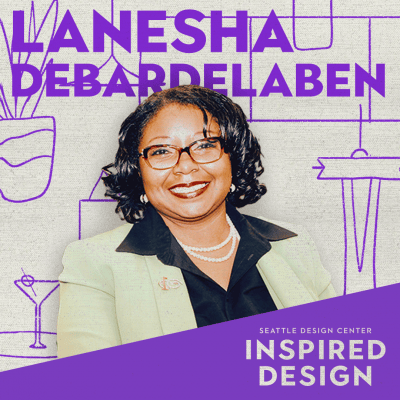
In this episode of Inspired Design, LaNesha DeBardelaben, President and CEO of Northwest African American Museum (NAAM) meets us at her place of inspiration, the Douglass-Truth branch of the Seattle Library. LaNesha will reveal her historical twin and help you find yours while taking you on a soulful journey that transcends time and space.
Statement by LaNesha in response to Gov. Inslee Signing Legislation to Make Juneteenth a Legal State Holiday In Washington
“The passage of legislation to make Juneteenth a legal, statewide holiday establishes Washington as a national leader in acknowledging, educating, and celebrating a more inclusive American history. As an institution dedicated to spreading knowledge, understanding, and enjoyment of the histories, arts, and cultures of African Americans in the Northwest, NAAM was proud to work with Inspire Washington on the advocacy of this legislation and to champion its passage, as noted in the Crosscut op ed here. Juneteenth is an important part of our history and culture — not Black history, but American history. Inclusive recognition and anti-racist education are essential in building understanding and paving the way toward a more just society. This June 19, NAAM will honor Juneteenth by collaborating with nine other African American museums across the country to host a virtual celebration that people can join from anywhere in the world. For the local community, we will also host an outdoor Jubilee Day Jamboree in Seattle.”
Episode Transcript
Speaker 1:
This is my favorite spot in Seattle. Besides the Northwest African American Museum this is the space and place that gives me so much joy and serenity and calm. And it’s a space for reflection and perfection.
Gina Colucci:
I’m Gina Colucci with the Seattle Design Center. Every week on Inspired Design we sit down with an iconic creator in a space that inspires them. Today I’m speaking with LaNesha DeBardelaben, President and CEO of the Northwest African American Museum. She came to Seattle from Detroit, where she was the senior vice president at the Charles H. Wright Museum of African American History. She has global experience with museums and libraries in Kenya, Ghana, South Africa, England, Germany, and Israel, and is involved in both the International Council of Museums and the International Women’s Forum. That’s why I was a little surprised when LaNesha suggested the Douglass-Truth Branch of the Seattle Public Library as the inspiring location of our conversation.
LaNesha DeBardelaben:
I have been drawn to libraries ever since I was a little girl. I was reserved, I was an introvert, and libraries naturally were spaces where I just felt comfortable. I felt like I could be myself, and I’ve always been curious about history and about culture, and libraries are places that are full of knowledge and information about history and culture.
Gina Colucci:
I learned how museums and libraries are intertwined in LaNesha’s personal and professional life, and in our society as a whole.
LaNesha DeBardelaben:
I fell in love with the inner workings, the inner feel the energy of the library. As soon as you walk in, you are faced with these beautiful portraits of Sojourner Truth and Frederick Douglas. And again, these are individuals that I’ve been studying since a little girl, going to the library spending every day after school reading about black history. And the Douglass-Truth library is an institution that houses the largest African American historical and literary collection in the West Coast. That is so impressive. That’s a point of pride, and that drew me here as well. So there are just so many aspects about the Douglass-Truth Library that literally made it, like my second home, just like when I was a little girl, the library was always my second home and here in Seattle this is like my second home. We are right in the heart of the city at 23rd and Yesler.
Gina Colucci:
The library extends beyond the walls of the building itself. It has strong roots in the central district.
LaNesha DeBardelaben:
In the 1940s and ’50s, and definitely by the ’60s, the central district was a predominantly African American community and the residents of the city at that time ensured that this library would reflect the African American rich literary and artistic traditions. And so we are graced, these walls are graced with the artwork of brilliant artists of color. If you look behind you, that artwork on the wall, that’s the work of an award winning local black woman artist, Marita Dingus. And the two portraits of Sojourner Truth and Frederick Douglas were done by a local artist, Eddie Ray Walker, and the other artwork that adorns these walls, they reflect the rich cultural diversity that has always been found in the central district. And so it just enriches the soul to be in this space.
LaNesha DeBardelaben:
Like it’s not just the books that are on the shelf here that enrich us. It’s the artwork. It’s the rooms that are in this library, named after important trailblazing African American men and women and families of this community, pioneers like the Gayton Family Meeting Room, the Gayton family is just an influential African American family, who they were pioneers here. They’ve been here since the 1880s. And then we have the Louise McKinney reading room named after the former first lady of Mount Sinai Baptist church, the first Baptist African-American congregation founded in 1890 here in Seattle. So we learned so much about African American history, about Seattle and about ourselves at the Douglass-Truth Library.
Gina Colucci:
Because LaNesha so firmly believes in the connection between history and each person’s story, I wanted to ask about her story and how museums became her profession and her calling?
LaNesha DeBardelaben:
The interesting thing is that I grew up in poverty in a small town in Saginaw, Michigan, two hours north of Detroit. And because of the impoverished conditions of my family and community, I did not attend museums until college. My junior year in college was my first real museum experience. So growing up, not only did I not go to museums, because it was across town and there were economic barriers, there was an admission fee. And so that’s why I spent all my time in the public library. And it was not until my going into my junior year in college, I was studying history. I was planning to be a high school history teacher. And I happened upon this internship at a museum and was not aware of career options in museums, because I did not see anybody that looked like me in museums. I did not have full access to museums economically.
LaNesha DeBardelaben:
It was not in my purview at all. That internship experience changed the trajectory of my career entirely. And this was while I was overseas as an exchange student in Nairobi Kenya. And so my first experience was in a black museum, an African museum. And I saw myself all around, because these were people of color who were museum educators and museum administrators and museum curators. And with my passion for history and for education and for literacy, my world changed, because I could bring all of this together, all of my passions together in a career in museums, and I’ve not looked back, that was 28 years ago. And the museum field has truly been a dream come true for me. It doesn’t feel like work. It never feels like work. Because it is surrounding myself with the stories of the past that have always fueled and nourished my soul. And so the work feeds me and strengthens me and is so seamlessly aligned with my purpose, my passion, and my calling. And so there is no other career field for someone who is so drawn to telling and preserving the stories of the past.
Gina Colucci:
That’s amazing. It’s not every day you get to talk to somebody who has that initial, that definite, this is when I was inspired to take this career path. You know, something sparked you and you just ran with it. And it’s really amazing. You kind of mentioned the speaking to your soul, is there a art piece or a exhibit that just split you wide open?
LaNesha DeBardelaben:
Absolutely. You know there is, Gina. It is in Memphis, Tennessee. The National Civil Rights Museum is a historic site. It is the assassination site of Dr. Martin Luther King Jr. It’s where he spent his last night, took his last breath. And in 1991 the site became a museum, a public museum. And since the day they opened, they have been educating through exhibitions on the power of the civil rights movement and the legacy of Dr. King’s life. And in 2014 that museum underwent an extensive multimillion dollar renovation. And shortly thereafter I visited that museum, and it literally brought me to my knees standing in front of room 306, and listening to Mahalia Jackson sing Reverend Dr. Martin Luther King Jr’s favorite hymn, Precious Lord take my hand.
LaNesha DeBardelaben:
(singing)
LaNesha DeBardelaben:
It is the most soul stirring, heart touching, exhibition experience I have ever encountered. And I encourage everybody, if you get a chance to go to Room 306 of the Lorraine Motel, which is now the National Civil Rights Museum in Memphis, Tennessee, your soul will be moved when you hear Mahalia Jackson as you walk toward 306, the hotel room of Dr. King’s assassination site. There is nothing like that museum experience for a visitor.
Gina Colucci:
Just hearing you speak of it gives me chills. You know, having that experience for you and being the president and CEO of the Northwest African American Museum. Do you hope that you can have an impact on somebody like that exhibit had an impact you?
LaNesha DeBardelaben:
Museum exhibitions are spaces where we should leave differently from how we entered the gallery, and exhibitions that help people to have an open mind and a changed heart are exhibitions that are really fulfilling their mission.
Gina Colucci:
And we need that right now. Yes, we do. We talk about a lot of places that inspire people, but is there a person that inspires you?
LaNesha DeBardelaben:
Oh, so many. So let me just think. I believe that we all have a historical twin, someone in the past that we strive to look like, that we strive to emulate their strength, their tenacity, their resolve, their drive. And I believe that if we just reflect on who we are striving to be, we will come to discover and realize who our historical twin is. And my historical twin gives me such inspiration. I think about her daily. Her example keeps me going when I get tired and become a bit weary and become a bit frustrated with the challenges I’m facing. I think about Mary McLeod Bethune and what she faced and how she overcame it. Gives me the strength to face whatever comes my way and to overcome it. So Mary McLeod Bethune was born in 1875 in South Carolina as the 17th of 17 children to formally enslaved parents.
LaNesha DeBardelaben:
And she was the only sibling who was afforded an education and her family entrusted her said, “Mary, you’re the only one that’s going to be able to get this education. So use it to make us all better.” She took that expectation seriously. And she went on to study in college and become an educator. She wanted to be a missionary, but, into Africa, but black women at that time were not allowed to be missionaries in Africa from Moody Bible College, where she was in Chicago. And so she instead went into education and it became her calling. And she started a college with a $1.50 cents and faith. And she established the National Council of Negro Women in 1935. She was an advisor to Franklin Roosevelt, a close friend to Eleanor Roosevelt.
LaNesha DeBardelaben:
And she was one of the most influential black women in politics during one of the most transformative times in African American history during World War II going into the 1950s. Mary McLeod Bethune was an institution builder when African Americans were not allowed to go to the hospital in Daytona Beach, Florida, because they had quotas on the number of African Americans that the mainstream hospital would serve, Mary McLeod Bethune started her own hospital. When African Americans were not allowed to go to the library in Daytona Beach, Florida, Mary McLeod Bethune started her own library. She started her own college. And so she was fearless and she did not let anything stop her. And so I strive to be that kind of institution builder. I strive to carry that kind of determination into the work that I do.
LaNesha DeBardelaben:
I’m striving to look like Mary McLeod Bethune and it is what keeps me going and striving to make a difference the way that she did, because I too am one of the, I’m the first in my immediate family to go to college. And I realized that everything that I do is in service to others to make my family proud the way that Mary McLeod Bethune made hers proud. That same expectation that was on her is on me. And so I’m just grateful that her example gives me a model of leadership and selfless influence that I hope.
Gina Colucci:
You definitely are. Those are big shoes to fill, you are well on your way. As our tour took us to the new edition of the library, you descend down this beautiful staircase. And once at the bottom we rounded the corner and right there is this huge display.
LaNesha DeBardelaben:
This is my absolute favorite space. My heart is swelling with pride right now.
Gina Colucci:
To describe what we were looking at. It’s a floor to ceiling glass case filled with images representing the rich history of black women in Washington State and beyond.
LaNesha DeBardelaben:
We are at the display case of Alpha Kappa Alpha Sorority Delta Upsilon Omega Chapter. This display case tells the story of African Americans in this community, in this city, in this state, through the lens of the oldest black sorority in the country.
Gina Colucci:
It holds personal meaning for LaNesha, an Alpha Kappa Alpha member herself.
LaNesha DeBardelaben:
Yes, yes, yes. This exhibition space is always telling the African American story by African American women of this community. This sorority donated the … At that time, it was called the Negro Collection. It was in 1965 and the Alpha Kappa Alpha Sorority Delta Upsilon Omega Chapter, which is located here in Seattle, comprised of college educated African American women leaders in all kinds of fields and industries. These are all professional women that come together to serve community in a shared sisterhood. And it’s so inspiring to see that they have dedicated since 1965 their financial and volunteer hours to ensure that this display is always adorned with black history, black art and black culture. It is truly an inspiration. This is my absolute favorite spot, because it was in a space like this that drew me to African American history as a small child, as a six-year-old, seven-year-old girl, going to the library, I was drawn to displays like this that allowed me to see myself and see who I could be.
LaNesha DeBardelaben:
And here we are looking into this display case and seeing women like Ida B. Wells, Nannie Helen Burroughs, Anna Julia Cooper, Mary Church Terrell, Sojourner Truth. These women reflect the best of black womanhood. It just almost brings me to tears, because it is what so many of us have dedicated our lives to doing, to preserving this history. So that we can always know who we are, who we can be. And that we are always working on becoming our best self. I encourage individuals to come and to stand in front of this Delta Upsilon Omega Chapter Alpha Kappa Alpha Sorority display case, because there is going to be some historical truth that you need to know, and it’s told here in this display case. And it helps us all to become better, no matter what our gender may be, no matter what our ethnicity may be.
LaNesha DeBardelaben:
These are stories of individuals who overcame odds and we all face hardships and challenges in our lives. All of us, no matter who we are, no matter our age, our ethnicity. And these stories inspire us to find a way to hold on, to get through, to overcome the challenges that we all face in our lives.
Gina Colucci:
As we walked up closer to it, you could see this title.
LaNesha DeBardelaben:
Lifting as We Climb. That was the motto, and that still is the motto of the National Association of Colored Women’s Clubs. This is an organization that was established in 1896 when black women were rejected from joining the National Association of Women’s Clubs. They had to organize themselves and create their own organization so that they could employ their leadership, their commitment to community, pull their resources together to serve their community. And to build a better way for African Americans. And so this model, Lifting as We Climb is a mantra that all of us should live by. We are all climbing, we’re all striving to become better in our personal lives, in our family lives, in our professional lives. As we climb, let’s lift up somebody else. Let’s help somebody else as we help ourselves. These black women have lived by this. They have led by this, and they have died by this.
LaNesha DeBardelaben:
They have spent their lives giving their best as they strive to be their best. It’s a lesson for all of us. Their legacy teaches and instructs us all on how to do what we can when we can, how we can, to improve the life of others. That’s what Lifting as We Climb is all about. This sorority, Alpha Kappa Alpha Sorority is the sorority that our first female vice president is a member of. And she joined the sorority at a historically black college, Howard University. And so we are at a point of transition and redefinition of what kind of country we will be. And we have to lift as we climb in order for us, all of us, to continue on this path of becoming a better country for all, a more equitable country for all.
Gina Colucci:
Hey, if you’re inspired to find your historic twin, head to Instagram and comment on the post for this episode, Inspire Design is brought to you by the Seattle Design Center. The show is produced by Larj Media. You can find them at larjmedia.com. Special, thanks to Michi Suzuki, Lisa Willis, and Kimmy Design for bringing this podcast to life. For more, head to seattledesigncenter.com, where you can subscribe to our newsletter and follow us on social media. On the next episode of Inspired Design, Linda Derschang gives us all the juicy behind the scenes details about Linda’s Tavern and her layer design process.
Speaker 1:
All right so can you please find an avocado green, a pink, purple, some kind of colored sync. And I just think that sync is fantastic.


